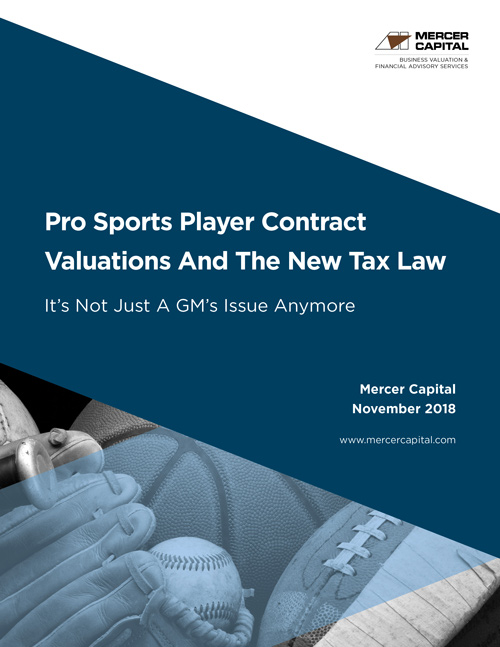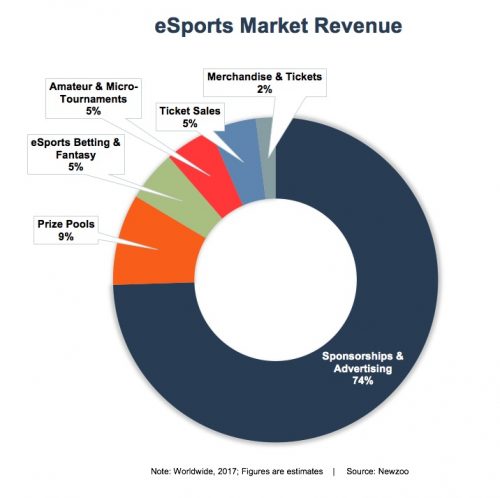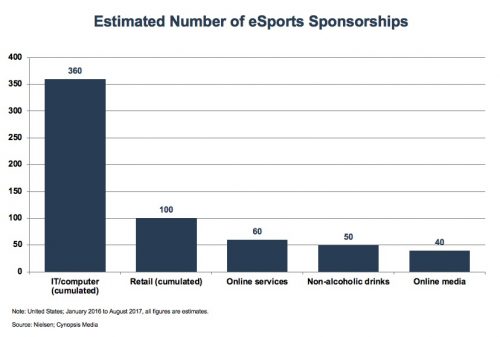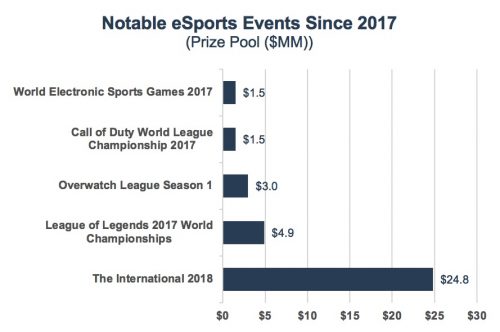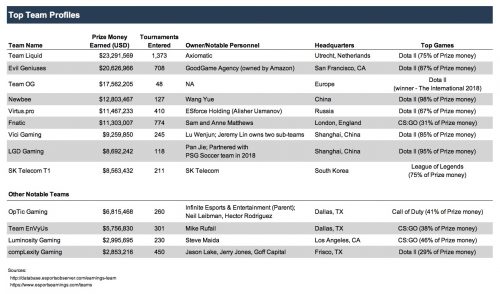2019 Outlook: Gasping for Air Replaces 2018’s Rainbow Chasing
What a difference a year makes. A year ago corporate tax reform had been enacted that lowered the top marginal tax rate to 21% from 35%. Banks were viewed as one of the primary beneficiaries through a reduction in tax rates and a pick-up in economic growth. Now investors are questioning whether bank stocks and other credit investments are canaries in the U.S. economic coalmine.
As 2018 draws to a close, bank fundamentals are very good; however, bank stock prices have tanked. SNL Financial’s small-, mid-, and large-cap bank indices have fallen by more than 20% since August 31, which meets the threshold definition of a bear market (i.e., down 20% vs. 10% for a correction).
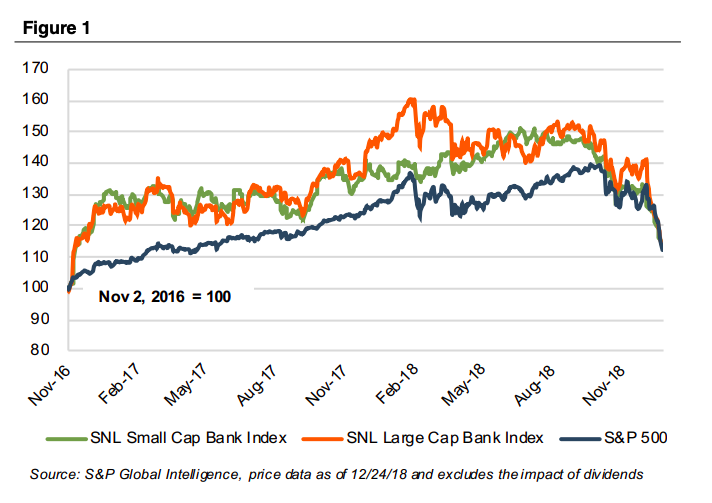
Markets, of course, lead fundamentals, and corporate credit markets lead equity markets. Among industry groups, bank stocks are “early cyclicals”, meaning they turn down before the broader economy does and tend to turn up before other sectors when recessions bottom.
Large cap banks peaked in February while the balance of the industry peaked in the third quarter after having a fabulous run that dates to the national elections on November 8, 2016. The downturn in bank stock prices corresponds with weakening home sales, widening credit spreads in the leverage loan and high yield bond markets, a ~40% reduction in oil prices, and a nearly inverted Treasury yield curve.
To state the obvious: markets—but not fundamentals so far—are signaling 2019 (and maybe 2020) will be a more challenging year than was assumed a few months ago in which the economy slows and credit costs rise. The key question for 2019 then is: how much and is a slowdown fully priced into stocks?
Our next issue of Bank Watch will entail a deep dive into credit, but for this issue, we observe that a global unwind of leverage is underway as the Fed extracts liquidity from the system. Bond buying (QE) and ultra-low rates helped drive asset prices higher. The reverse is proving true, too.
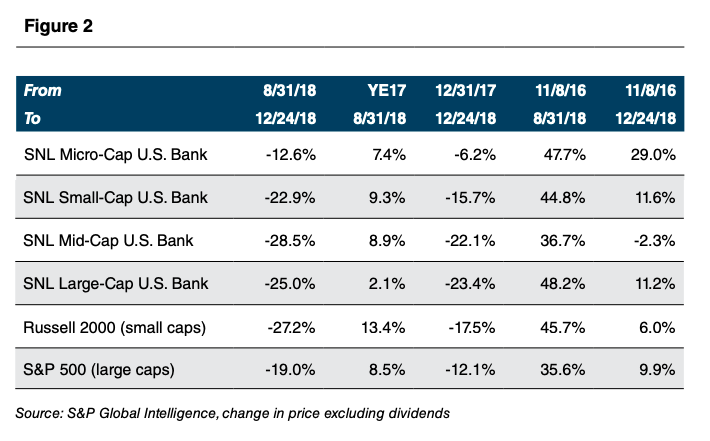
Bank Fundamentals
Bank fundamentals are in good-to-great shape. During the third quarter all FDI-Cinsured institutions reported aggregate net income of $62 billion, up 29.3% from 3Q17. Excluding the impact of lower taxes, 3Q18 pro forma net income would have been about $55 billion, up 13.9% from 3Q17. The data is more nuanced once the industry is segregated by asset size, however.
As shown in Figure 3, ROA and ROE have nearly rebounded to the last pre-crisis year of 2006. Importantly, capital has increased significantly and, thereby, provides an additional buffer whenever the next downturn develops.
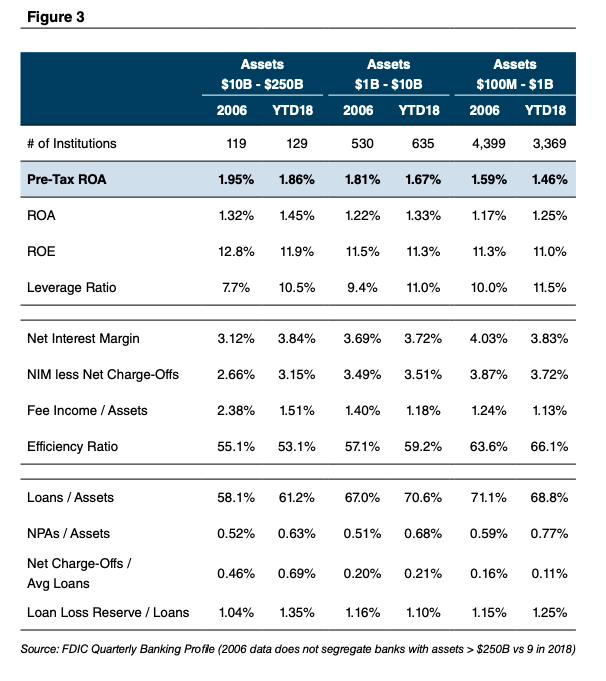
As it relates to 2019, bank fundamentals are not expected to change much other than credit costs are expected to increase from a very low level in which current loss rates in all loan categories are below long-term averages. Wall Street consensus EPS estimates project mid-single digit EPS growth for the largest banks, primarily as a result of share repurchases and a slightly higher full year NIM, while regional and community bank consensus estimates reflect upper single digit EPS growth from the same factors and somewhat better loan growth.
However, credit and equity markets imply the consensus is too high given the sharp widening in credit spreads and drop in bank stock prices the past several months. Although markets lead fundamentals, market signals about magnitude are less clear. Given continuing growth in the U.S. economy that on balance will be helped by lower oil prices, it seems reasonable that an increase in credit costs the market is forecasting will be modest, and as a result, bank profitability will not be meaningfully crimped in 2019.
The Fed: 2019 Rate Hikes Seem Unlikely
Whenever the Fed embarks on an extended rate hiking campaign, the saying goes the Fed hikes until something breaks. The market is signaling that the December rate hike—the ninth in the current cycle—that pushed the Fed Funds target from 2.25% to 2.50% when the yield on the 10-year UST bond was ~2.8% may be one of those moments. What’s unusual about the current tightening cycle is it represents an attempt by the Fed (but not the BOJ, ECB or SNB) to extract itself from radical monetary policies in which the Fed is raising short-term rates and shrinking its balance sheet at the same time.

Given the flat yield curve, it is hard to see how the Fed will hike the Fed Funds another couple of times as planned for 2019, unless the Fed wants to invert the yield curve or unless intermediate- and long-term rates reverse and trend higher. Presumably the $50 billion a month pace in the reduction of its US Treasury and Agency MBS portfolio will continue. Alternatively, perhaps the Fed will bow to the market and not raise rates in 2019 and slow or even halt the reduction in its balance sheet to stabilize markets.
As it relates to bank fundamentals, the impact on net interest margins will depend upon individual bank balance sheet compositions. Broadly, however, a scenario of no rate hikes implies less pressure to raise deposit rates, and rising wholesale borrowing rates should stabilize. The result, therefore, should be a little bit better NIMs than a slight reduction if the Fed continues to hike given that deposit rate betas for many institutions are well over 50% now. More important for banks if the Fed pauses vs continues to hike would be the impact on asset values (higher all else equal) and, therefore, credit costs.
Bank Valuations: Support but Never a Stand-Alone Catalyst
A synopsis of bank valuations is presented in Figure 4 in which current valuations for the market cap indices are compared to the approximate market top around August 31, November 8, 2016 when the national election occurred, and multi-year medians based upon daily observations. An important point is that valuation is not a catalyst to move a stock; rather, valuation provides a margin of safety (or lack thereof) and thereby can provide additional return over time as a catalyst such as upward (or downward) earnings revisions can cause a multiple to expand or contract.
Bank stocks—particularly mid-cap and large-cap banks—enter 2019 relatively inexpensive to history. The stocks are cheap relative to 2019 consensus earnings with large cap banks trading around 8x and small cap banks at 10x; however, the market’s message is that the estimates are too high. It is hard to envision that estimates are dramatically too high as proved to be the case in 2008 unless the economy is poised to roll-over hard, which seems unlikely. Assuming no recession or a shallow recession, then, the modest valuations may result in bank stocks having a good year even if fundamentals weaken and analysts cut estimates because the limited downside in earnings had been adequately priced into the stocks by late December.
Bank M&A: Slowing Activity for 2019 Likely
Outwardly, 2018 has been another good year for bank M&A even though activity slowed in the fourth quarter. There were few notable deals other than Fifth Third’s pending acquisition of Chicago-based MB Financial valued at $4.8 billion at announcement and Synovus Financial’s pending acquisition of Boca Raton-based FCB Financial Holding valued for $2.8 billion at announcement. Even before bank stocks rolled over the shares of both Fifth Third and Synovus severely underperformed peers as investors questioned the exchange ratios, cost saving assumptions, credit risk (especially at FCB), and whether the buyers could keep the franchises intact as key personnel defected elsewhere.
The national average price/tangible book multiple expanded to 173% from 166% in 2017 and about 140% in 2014, 2015 and 2016 before the sector was revalued in the wake of the national election. The median P/E of 25x was within the five-year range of 21x to 28x.
The total number of bank and thrift transactions through December 24 totaled 261, which equated to 4.4% of the commercial bank and thrift charters as of year-end 2017. During 2014–2018, the number of acquisitions exceeded 4% each year except for 2016 when activity at the beginning of the year was hampered by weak stock prices as a result of a slowing economy that was marked by a collapse in oil prices and sharply wider credit spreads.
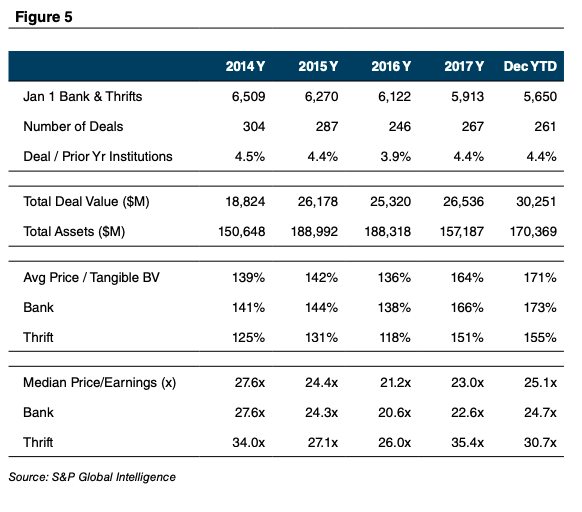
Weak bank stock prices crimp the ability to negotiate deals because most sellers are focused on absolute price rather than relative value when taking the buyer’s shares as consideration; and, buyers usually are unwilling to increase the number of shares being offered given a limitation on minimum acceptable EPS accretion and maximum acceptable TBVPS dilution. A notable late year exception occurred when Cadence Bancorporation opted to increase the number of shares it will issue to State Bancorp by 9.6% because the double trigger in the merger agreement signed during May when Cadence’s share price was much higher came into play.
Although there is no change in the driver of consolidation such as succession issues, shareholder liquidity needs, and economies of scale, a slowdown in M&A activity in 2019 is likely because bank stocks will enter the year depressed. Deals that entail some amount of common share consideration will be tough to structure unless sellers will be willing to take less, which most will not do with operating fundamentals in good shape for now. All cash deals will be impacted less, but all cash deals are more prevalent among very small institutions in which pricing usually occurs at a discount to those that entail some proportion of common shares.
Summing It Up
The market is shouting fundamentals will weaken in 2019 after a long period of gradual improvement following the Great Financial Crisis, which most likely will be reflected in sluggish loan growth and modestly higher credit costs; however, bank stocks may surprise to the upside as they did to the downside in 2018 provided a) there is no recession or a shallow one; and, b) the Fed relents and does not hike further and potentially slows the run-off of its excess bonds (and liability reserves). For clients of Mercer Capital who obtain year-end valuations, rising stock prices since the presidential election may be reversed partially, given the compression in market price/earnings and price/tangible book value multiples that occurred in 2018.
Adjusted Earnings and Earning Power as the Base of the Valuation Pyramid
The extensive use of core versus reported earnings by public companies has been a widespread phenomenon for at least 25 years. During the past decade, the practice also has become widespread among companies (and their bankers who market deals) that are issuing debt in the leverage loan and high yield markets.
The practice is controversial. The SEC periodically will crack down on companies it thinks are pushing the envelope. Bank regulators have raised the issue of questionable adjustments to borrowers’ EBITDA for widely syndicated leverage loans.
Investors are aware of the issue, too, but have not demanded the practice to stop. In mid-2017, I attended a conference on private credit. One session dealt exclusively with adjusted EBITDA. One panelist offered that adjustments in the range of 5-10% of reported EBITDA were okay, but the consensus was the adjustments were out of control. Covenant Review reported that as of mid-2017 the average leverage for middle market LBOs over the prior two years was 5.5x based upon the target’s adjusted EBITDA compared to reported EBITDA of ~7x. The issue is no better, and perhaps worse, in 2018 judging from market sentiment.
If investors are solely relying upon company defined adjusted EBITDA, then they may be vacating their fiduciary duties when investing capital. That said, an analysis of core versus reported earnings is a critical element of any valuation or credit assessment of a non-early stage company with an established financial history.
Table 1 below provides a sample overview of the template we use at Mercer Capital. The process is not intended to create an alternate reality; rather, it is designed to shed light on core trends about where the company has been and where it may be headed.
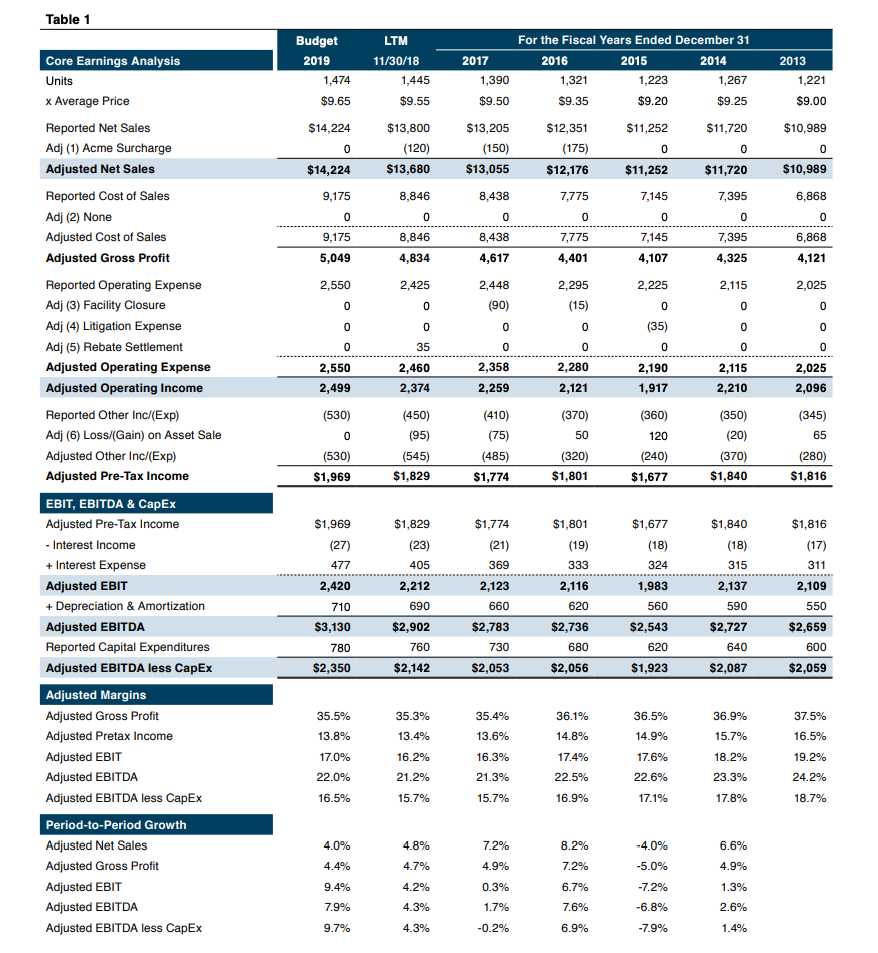
Adjustments
Adjustments typically consist of items that are non-recurring, unusual, and infrequent. They also may entail elements for a change in business operations, such as the addition of a new product or the discontinuation of a division. This is where judgment is particularly important because we have noticed a trend among some investors to credit businesses with future earnings for initiatives such as stepped-up hiring of revenue producers in which a favorable outcome is highly uncertain.
Minority vs. Control
Adjustments considered should take into account whether the valuation is on a minority interest or controlling interest basis. An adjustment for an unusual litigation expense will not be impacted by the level-of-value; however, other potential adjustments—particularly synergies a buyer could reasonably be expected to realize would only apply in a control valuation.
Core Trends vs. Peers
The development of the adjusted earnings analysis should allow one to identify the source of revenue growth and the trend in margins through a business cycle. The process also will facilitate comparisons with peers both historically and currently to thereby make further qualitative judgments about how the business is performing.
Out Year Budget vs. Adjusted History
The adjusted earnings history should create a bridge to next year’s budget, and the budget a bridge to multi-year projections. The basic question should be addressed: Does the historical trend in adjusted earnings lead one to conclude that the budget and multi-year projections are reasonable with the underlying premise that the adjustments applied are reasonable?
Core Earnings vs. Ongoing Earning Power
Core earnings differ from earning power. Core earnings represent earnings after adjustments are made for non-recurring items and the like in a particular year. Earning power represents a base earning measure that is representative through the firm’s (or industry’s) business cycle and, therefore, requires examination of adjusted earnings ideally over an entire business cycle. If the company has grown such that adjusted earnings several years ago are less relevant, then earning power can be derived from the product of a representative revenue measure such as the latest 12 months or even the budget and an average EBITDA margin over the business cycle.
Platform Companies/Roll-Ups
Companies that are executing a roll-up strategy can be particularly nettlesome from a valuation perspective because there typically is a string of acquisitions that require multiple adjustments for transaction related expenses and the expected earnings contribution of the targets. The math of adding and subtracting is straightforward, but what is usually lacking is seasoning in which a several year period without acquisitions can be observed in order to discern if past acquisitions have been accretive to earnings. Public market investors struggle with this phenomenon, too, but often the high growth profile of roll-ups will trump questions about earning power and what is an appropriate multiple until growth slows.
Income and Market-Based Valuation Approaches
In addition to providing insight into how a business is performing, the adjusted earnings statement will “feed” multiple valuation methods. These include the Discounted Cash Flow and Single Period Earning Power Capitalization Methods that fall under the Income Approach, and the Guideline (Public) Company and Guideline (M&A) Transaction Methods that constitute Market Approaches.
It may be obvious, but we believe an analysis of adjusted (and reported) earnings statements for a subject company over a multi-year period is a critical, if not the critical element, in valuing securities that are held in private equity and credit portfolios. Mercer Capital has nearly 40 years of experience in which tens of thousands of adjusted earnings statements have been created. Please call if we can help you value investments held in your portfolio.
Originally published in Mercer Capital’s Portfolio Valuation Newsletter.
Value Drivers of a Store Valuation
Auto dealers, like most business owners, are constantly wondering about the value of their business. It’s easy to see how this issue moves to the forefront around certain events such as a transaction, buy-sell agreement, litigation, divorce, wealth-transfer event, etc. As our previous article “Six Different Ways to Look at a Dealership” points out, there are many other instances when a dealer can evaluate the condition, progress, or value of their store. Dealers can actually influence the value of their store prior to these obvious events by understanding the value drivers of a store valuation and addressing them on a consistent basis. So what are some of the value drivers of a store valuation?
Franchise
A store’s particular franchise affiliation has a major impact on value. Each franchise has a different reputation, selling strategy, target consumer demographic, etc. Public and value perception of franchises can be unique and are most easily illustrated through blue sky multiples. As the Haig Report and Kerrigan’s Blue Sky Report indicate, these blue sky multiples can vary over time and from period to period. Often stores and franchises are grouped into broader categories, such as: luxury franchises, mid-line franchises, domestic franchises, import franchises and/or high line franchises.
Real Estate/Quality of Facilities
Typically, most store locations and dealership operations are held in one entity, and the underlying real estate is held by a separate, often related, entity. Several issues with the real estate can affect a store valuation. First, an analysis of the rental rate and terms should be performed to establish a fair market value rental rate. Since the real estate is often owned by a related entity, the rent may be set higher or lower than market for tax or other motivations that would not reflect fair market value. Second, the quality and condition of the facilities are crucial to evaluate. Most manufacturers require facility and signage upgrades on a regular basis, often offering incentives to help mitigate these costs. It’s important to assess whether the store has regularly complied with these enhancements and is current with the condition of their facilities.
Employees/Management
The quality and depth of management can have a positive impact on a store valuation. Stores with greater management depth and less dependence on several key individuals will generally be viewed as less risky by an outside buyer. Also, a store’s CSI (Customer Service Index) and SSI (Service Satisfaction Index) rating can also influence incentives from the franchise and the overall perception of the consumer. A strong CSI and SSI are also a reflection of a strong service department and a commitment to quality customer service.
Recent Economic Performance
Like most industries, the auto industry is dependent on the national economy. We report later on the current SAAR (Seasonally Adjusted Annual Rate) which is an indicator of economic performance and future sales in the auto industry. Current conditions of rising interest rates and a leveling out of the SAAR compared to October 2017 could be predictors of stabilizing values and less activity in the M&A market in the months to come. In addition to monitoring and understanding the current month’s SAAR, the longer-term history of the SAAR and its trends also provide insight into the auto industry and a store valuation. Below is a long-term graph of the SAAR from 2000 to 2017.
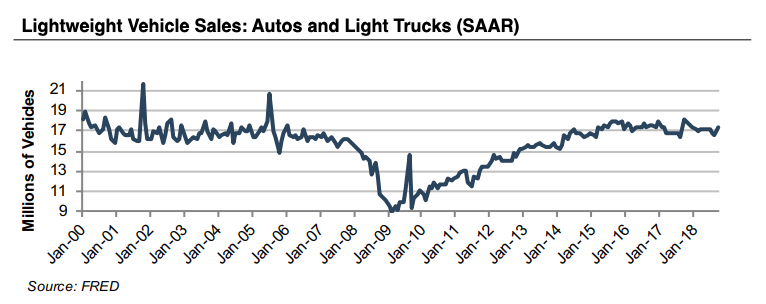
This visual evidence demonstrates the cyclicality of the auto industry. Unlike some industries that may be seasonal or cyclical in a given year, the auto industry tends to be cyclical over a longer period of several years. For instance, it’s common for a store to have stronger volumes and profitability for a period of 4-5 years, before experiencing a sluggish year or two. Store valuations should consider the cyclicality of the industry and not overvalue a store during a strong year, or undervalue it during a sluggish year.
Another indicator of economic performance is an analysis of the auto cycle and where we are in that cycle based upon the average age of cars owned. The figure below illustrates the peak and trough of the auto cycle and where we sit today.
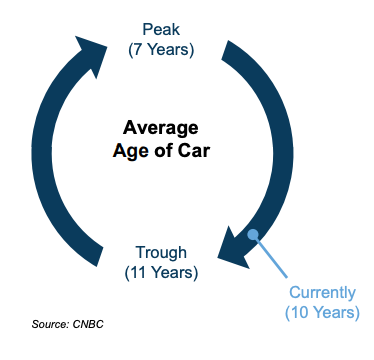
A store’s value and performance can be greatly influenced by the local economy as well as the national economy–sometimes more so. Certain markets are dominated by local economies of a certain trade or industry. Examples can be store locations near oil & gas refining areas, mining areas, or military bases. Each is probably more dependent on local economy conditions than national economy conditions.
Buyer Demand
Buyer demand in the transaction market can illustrate the value climate for store valuations. Typically, buyer demand is measured by the deal activity in the M&A market. The Haig Report indicated that the second quarter of 2018 transaction activity increased by 87% compared to second quarter of 2017. Further, the activity for the first six months of 2018 increased by 23% over the same six months of 2017. Similarly, Kerrigan’s figures reflect an increase in M&A activity of 13% in the first six months of 2018 compared to their data for the first six months of 2017.
Location/Market
The value of a store location can be more complex than urban vs. rural or major metropolitan city vs. minor metropolitan city. Each store location is assigned a certain area or group of zip codes referred to as an “area of responsibility” or “AoR”. Particularly, how does a location’s demographic characteristics line up with a certain franchise? For example, a high line store would perform better and seemingly be more valuable in a major metropolitan area with a high median income level, such as Beverly Hills or South Beach in Miami than in a mid western city. Conversely, mid-line stores would probably fare better in areas with more moderate median income levels.
Single-Point vs. Over-Franchised Market
The amount of competition in a store’s AoR, as well as the nearest location of a similar franchised store can also have an impact. It’s important to make the distinction that we are talking about a market and not a single-point store. A single-point market refers to a market where there is only one store of a particular franchise. An over-franchised market would be a larger market that may contain several stores of a particular franchise within a certain radius. Often, a store in a single-point market would be viewed as more valuable than one in an over-franchised market that would be competing with its own franchise for the same consumers. Additionally, the stores of the same franchise in the same market could be drastically different in size. One may be part of a larger auto group of stores, while the other may be a single-point dealership location, meaning its owner only owns that one location.
Conclusions/Observations
As we’ve discussed, the value of a store can be influenced by a variety of factors. Some of the factors are internal and can be affected by the owner, and some are external and are out of the control of the owner. To find out the value of your store, contact one of the automotive industry professionals at Mercer Capital.
Originally published in the Value Focus: Auto Dealer Industry Newsletter, Mid-Year 2018.
Six Different Ways to Look at a Dealership
Along the road to building the value of a dealership, it is necessary and appropriate to examine the dealership in a variety of ways. Each provides unique perspective and insight into how a dealer is proceeding along the path to grow the value of the dealership and if/when it may be ready to sell. Most dealers realize the obvious events that may require a formal valuation: potential sale/acquisition, shareholder dispute, death of a shareholder, gift/estate tax transfer of ownership, etc. A formal business valuation can also be very useful to a dealer when examining internal operations.
So, how does a dealer evaluate their dealership? And how can advisers or formal business valuations assist dealers examining their dealership? There are at least six ways and they are important, regardless of the size. All six of these should be contemplated within a formal business valuation.
- At a Point in Time. The balance sheet and the current period (month or quarter) provide one reference point. If that is the only reference point, however, one never has any real perspective on what is happening to the dealership.
- Relative to Itself Over Time. Dealerships exhibit trends in performance that can only be discerned and understood if examined over a period of time, often years.
- Relative to Peer Group. Many dealers participate in 20 groups. Among other things, the 20 groups can provide statistics that offer a basis for comparing performance relative to other dealerships.
- Relative to Budget or Plan. Every dealer of any size should have a budget for the current year. The act of creating a budget forces management to make commitments about expected performance in light of a company’s position at the beginning of a year and its outlook in the context of its local economy, industry and/or the national economy. Setting a budget creates a commitment to achieve, which is critical to achievement. Most financial performance packages compare actual to budget for the current year.
- Relative to Your Unique Potential. Every dealer has prospects for “potential performance” if things go right and if management performs. If a dealership has grown at 5% per year in sales and earnings for the last five years, that sounds good on its face. But what if similar locations have been growing at 10% during that period?
- Relative to Requirements by Franchise. Increasingly, dealerships are subject to requirements by the franchise including facility enhancements, working capital levels, CSI and SSI ratings, sales volumes, profitability, etc.
Why is it important to evaluate a dealership in these ways? Together, these six ways provide a unique way for dealers and key managers to continuously reassess and adjust their performance to achieve optimal results. A formal business valuation can communicate the dealership’s current position in many of these areas. Successive, frequent business valuations allow dealers and key managers the opportunity to measure and track the performance and value of the dealership or over time against stated goals and objectives.
Originally published in the Value Focus: Auto Dealer Industry Newsletter, Mid-Year 2018.
Valuing an eSports Team
The value of a company is generally dependent on three factors: risk, growth, and cash flow. Esports teams have an abundance of risk as well as growth potential. Considering eSports is a relatively new industry, the growth potential is huge. At the same time, and for the same reason, there is significant risk in the industry – it is too early to know if there is a proven, sustainable, cash flow generating business model.
Risk
Sustainability is one of the key risk factors for eSports teams. Viewer interest in games changes rapidly as new games are released. For the week of September 4, 2017, PLAYERUNKNOWNS’S BATTLEGROUNDS (“PUBG”) was the most viewed game with 112,741 average Twitch viewers. League of Legends (94,940) and Hearthstone (58,427) completed the top three. One year later, for the week of September 3, 2018, Fortnite led the way with 163,303 viewers while Counter-Strike: Global Offensive (129,580), and League of Legends (109,210) completed the top three. Hearthstone dropped to 36,849 average Twitch viewers for the week and PUBG dropped to 33,877 average Twitch viewers. Tracking viewership trends and competing in games that are popular is an important skill for teams that want to maintain relevance. Team Liquid’s CEO, Steve Arhancet, indicated the team looks for multiplayer games that have a thriving competitive community and are enjoyable to watch and play. Game publishers are another source of risk for eSports teams. The soon to be started Overwatch League (“OWL”) has a total buy-in price of $20 million split among its 20 teams. The high up-front cost to participate in the league has made some teams avoid the league.
Esports teams also have risks related to their players. Since eSports is not yet an established industry, there is not a set protocol for player contracts that allows teams to keep players for a long period of time. In addition, eSports teams must consider team dynamics when assembling a roster much like other professional team sports such as basketball, football, or hockey. If an eSports team does not have chemistry, it is unlikely they will perform at a high level. Frisco, Texas based eSports team CompLexity cited roster instability as a reason they dropped their Overwatch team.
Growth
As shown in the chart below, the industry has been growing rapidly over recent years.
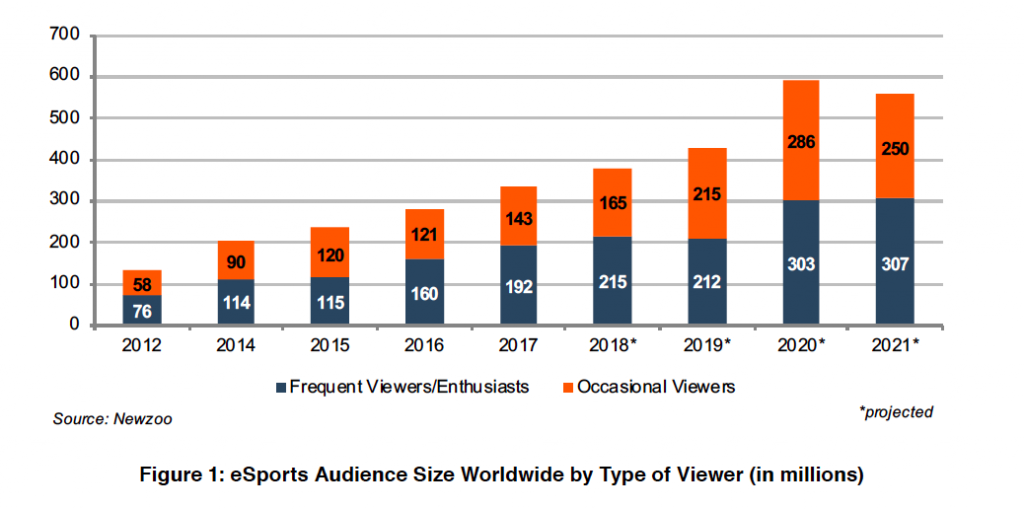
Esports industry research firm NewZoo projects 380 million total viewers in 2018, with 57% of those classified as frequent viewers/enthusiasts and 43% classified as occasional viewers. The compound annual growth rate of total viewers is projected to be 13.55% from 2017 to 2021.
Another area where growth can be observed is the prize pool for major eSports tournaments. For example, The International 8, held in 2018 set a record for the largest single tournament prize pool in eSports history for the fifth consecutive year at $25.5 million. Prior iterations of The International had prize pools as shown in Figure 2. The compound annual growth rate of the prize pool from 2014 to 2018 was 24%.

Newzoo defines industry revenue as the amount generated through the sale of sponsorships, media rights, advertising, publisher fees, tickets, and merchandising. Global eSports revenues are projected to reach $906 million in 2018. North America is projected to account for approximately 38% ($345 million) of global eSports revenue in 2018. As shown in Figure 3, global revenue for eSports is projected to reach $1.65 billion in 2021.
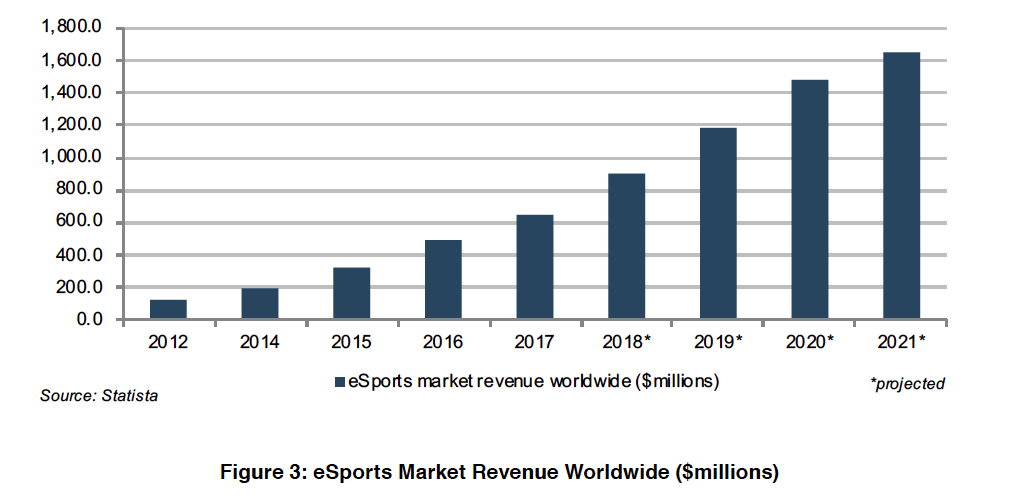
Cash Flow
Mercer Capital’s “eSports Business Models” shows how eSports teams make money and the costs of revenue associated with those income streams. Generally speaking, eSports teams have the following sources of revenue: sponsorships, broadcast revenue, merchandise sales, prize money, and naming rights. Costs of revenue include: player salaries, administrative personnel salaries, player housing expenses, training facility rent or operating expense, travel costs, and equipment/accessory expense. In broad terms, cash flow is calculated by subtracting operating expenses from total revenue.
Revenue can have different tiers of riskiness. For example, recurring revenue from sponsorships and subscriptions is less risky than merchandise sales or prize money. All else equal, teams with a higher ratio of recurring revenue to non-recurring revenue are considered less risky than a team with more non-recurring revenue than recurring revenue. Teams with lower risk cash flow are considered more valuable than teams with riskier cash flow.
Valuing an eSports Team
There are three approaches to value that are used or considered in any valuation. The three approaches to value are the cost approach, the income approach, and the market approach. This section walks through how an eSports team would be valued using each approach. Usually, valuation firms weight indications from each approach to arrive at a final conclusion of value.
Cost Approach
The cost approach is applied by adjusting the subject entity’s assets and liabilities to market value. Liabilities are then subtracted from assets to arrive at net asset value. A typical eSports team would have mostly intangible assets such as players. Tangible assets would be training facilities or team headquarters owned by the team. The cost approach, in many instances, would be weighted lightly, if at all, because it does not fully account for intangible assets.
Income Approach
The income approach is applied by calculating the cash flow either for a single period or for a projected multi-year period. At this stage, multi-year projections that account for potential growth will be the most common method employed. Capitalization at this point would be less likely to be used as growth has not stabilized within the industry. The risk and growth factors that would be considered for an eSports team will be the lynchpin to reasonably and properly measuring value. For an operating eSports team, the income approach would most likely be the heaviest weighted indication in a conclusion of value.
Market Approach
The market approach is similar to the income approach in that some element of cash flow is capitalized by some factor. However, in the market approach the capitalization factor is estimated using multiples indicated by public companies or transactions of private companies in the same or similar lines of business as the subject company. The market approach could be difficult to apply to an eSports team because, even though teams operate in the same general industry of eSports, there are many unique factors to each team. Within the market approach, cash flow, the capitalization factor(s)/multiple(s), or both may be adjusted based on how the subject team compares to the teams selected in the market approach. As the industry matures and more transactions occur, the market approach will develop alongside the industry.
Conclusion
In summary, eSports teams are valued using three methods: the cost approach, the market approach, and the income approach. Each of the methods considers three primary factors: risk, growth, and cash flow. Each eSports team is unique and there is no single formulaic way to value a team. However, in general, eSports teams will likely be valued using their historical and projected cash flows in the income approach. As the industry develops and matures there will be more transactions within the industry which will allow the market approach to become a more widely used tool.
Originally published in Mercer Capital’s Valuing an eSports Team whitepaper.
Control Issues in ESOP Purchase Transactions
Tim R. Lee, ASA delivered the presentation, “Control Issues in ESOP Purchase Transactions” at the 2018 Las Vegas ESOP Conference and Trade Show hosted by The ESOP Association (November 8-9, 2018).
A description of Tim’s session can be found below:
Many ESOP purchase transactions are made on a controlling interest valuation basis. However, as has been highlighted in DOL investigations and ESOP litigation, whether an ESOP has “control” is not always a crystal clear issue. In addition, the Appraisal Foundation has recently published its MPAP paper which addresses specific factors to consider, including but not limited to the company’s cash flows, when valuing a company on a controlling interest basis. This advanced session will explore several issues around the topic of control, including what “paying for control” really means, appropriate post transaction corporate governance and how control rights are reflected in an ESOP appraisal.
Noncompete Agreements for Section 280G Compliance for Banks
Golden parachute payments have long been a controversial topic. These payments, typically occurring when a public company undergoes a change-in-control, can in some cases draw the ire of political activists and shareholder advisory groups. Golden parachute payments can also lead to significant tax consequences for both the company and the individual. Strategies to mitigate these tax risks include careful design of compensation agreements and consideration of noncompete agreements to reduce the likelihood of additional excise taxes.
When planning for and structuring an acquisition, companies and their advisors should be aware of potential tax consequences associated with the golden parachute rules of Sections 280G and 4999 of the Internal Revenue Code. A change-in-control (CIC) can trigger the application of IRC Section 280G, which applies specifically to executive compensation agreements. Proper tax planning can help companies comply with Section 280G and avoid significant tax penalties.
Golden parachute payments usually consist of items like cash severance payments, accelerated equity-based compensation, pension benefits, special bonuses, or other types of payments made in the nature of compensation. In a CIC, these payments are often made to the CEO and other named executive officers (NEOs) based on agreements negotiated and structured well before the transaction event. In a single-trigger structure, only a CIC is required to activate the award and trigger accelerated vesting on equity-based compensation. In this case, the executive’s employment need not be terminated for a payment to be made. In a double-trigger structure, both a CIC and termination of the executive’s employment are necessary to trigger a payout.
Adverse tax consequences may apply if the total amount of parachute payments to an individual exceeds three times (3x) that individual’s “Base Amount”. The Base Amount is generally calculated as the individual’s average annual W-2 compensation over the preceding five years.
As shown in Figure 1, if the (3x) threshold is met or crossed, the excess of the CIC Payments over the Base Amount is referred to as the Excess Parachute Payment. The individual is then liable for a 20% excise tax on the Excess Parachute Payment, and the employer loses the ability to deduct the Excess Parachute Payment for federal income tax purposes.
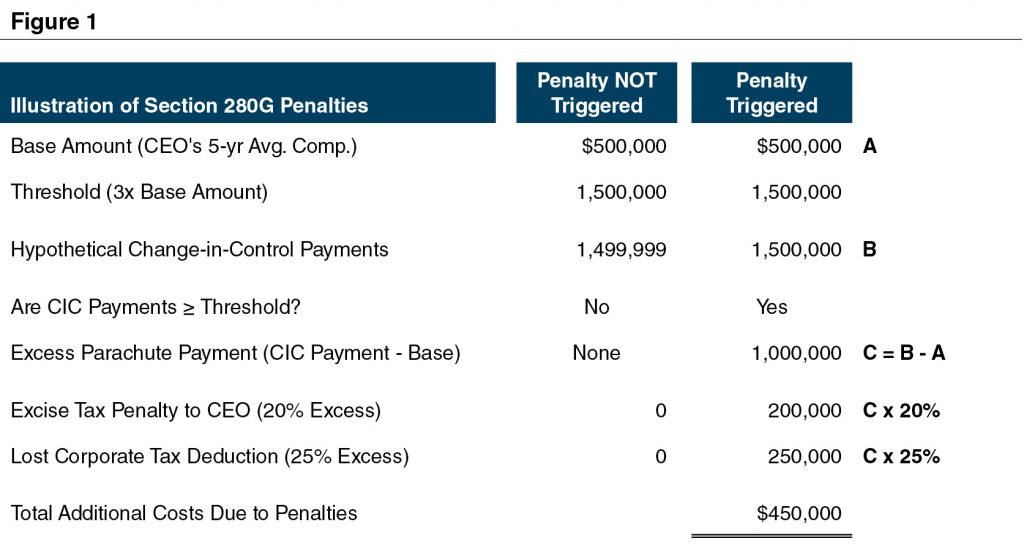
Several options exist to help mitigate the impact of the Section 280G penalties. One option is to design (or revise) executive compensation agreements to include “best after-tax” provisions, in which the CIC payments are reduced to just below the threshold only if the executive is better off on an after-tax basis. Another strategy that can lessen or mitigate the impact of golden parachute taxes is to consider the value of noncompete provisions that relate to services rendered after a CIC. If the amount paid to an executive for abiding by certain noncompete covenants is determined to be reasonable, then the amount paid in exchange for these services can reduce the total parachute payment.
According to Section 1.280G-1 of the Code, the parachute payment “does not include any payment (or portion thereof) which the taxpayer establishes by clear and convincing evidence is reasonable compensation for personal services to be rendered by the disqualified individual on or after the date of the change in ownership or control.” Further, the Code goes on to state that “the performance of services includes holding oneself out as available to perform services and refraining from performing services (such as under a covenant not to compete or similar arrangement).”
Figure 2 illustrates the impact of a noncompete agreement exemption on the calculation of Section 280G excise taxes.
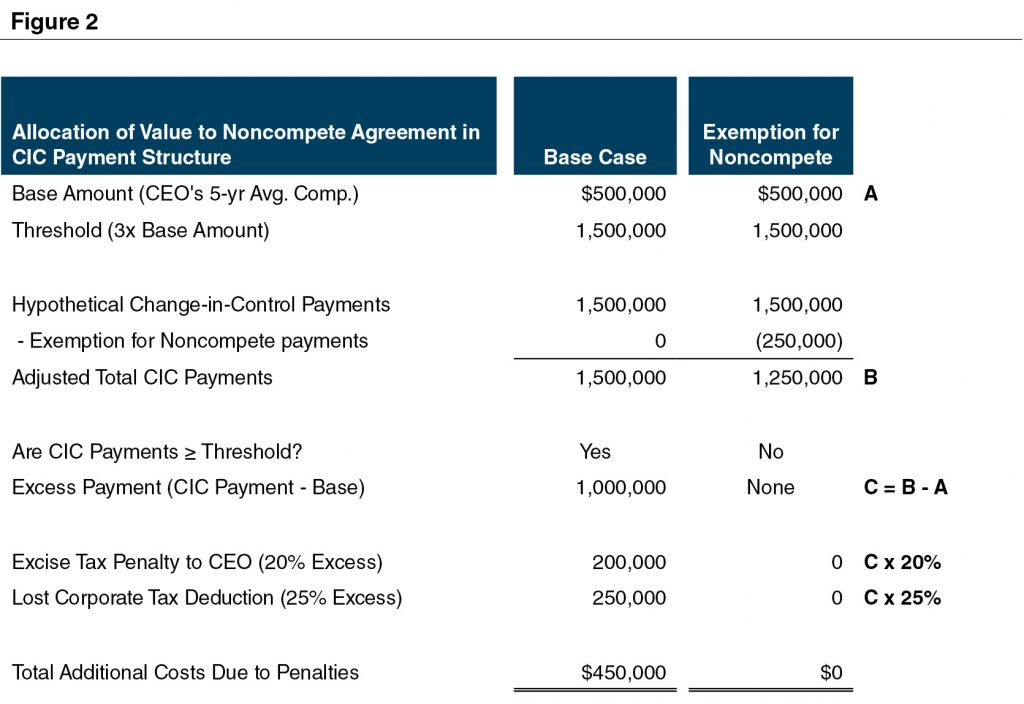
How can the value of a noncompete agreement be reasonably and defensibly calculated? Revenue Ruling 77-403 states the following:
“In determining whether the covenant [not to compete] has any demonstrable value, the facts and circumstances in the particular case must be considered. The relevant factors include: (1) whether in the absence of the covenant the covenantor would desire to compete with the covenantee; (2) the ability of the covenantor to compete effectively with the covenantee in the activity in question; and (3) the feasibility, in view of the activity and market in question, of effective competition by the covenantor within the time and area specified in the covenant.”
Some of the factors to be considered when evaluating the “economic reality” of a noncompete agreement have been enumerated in various Tax Court cases, as detailed in Figure 3.
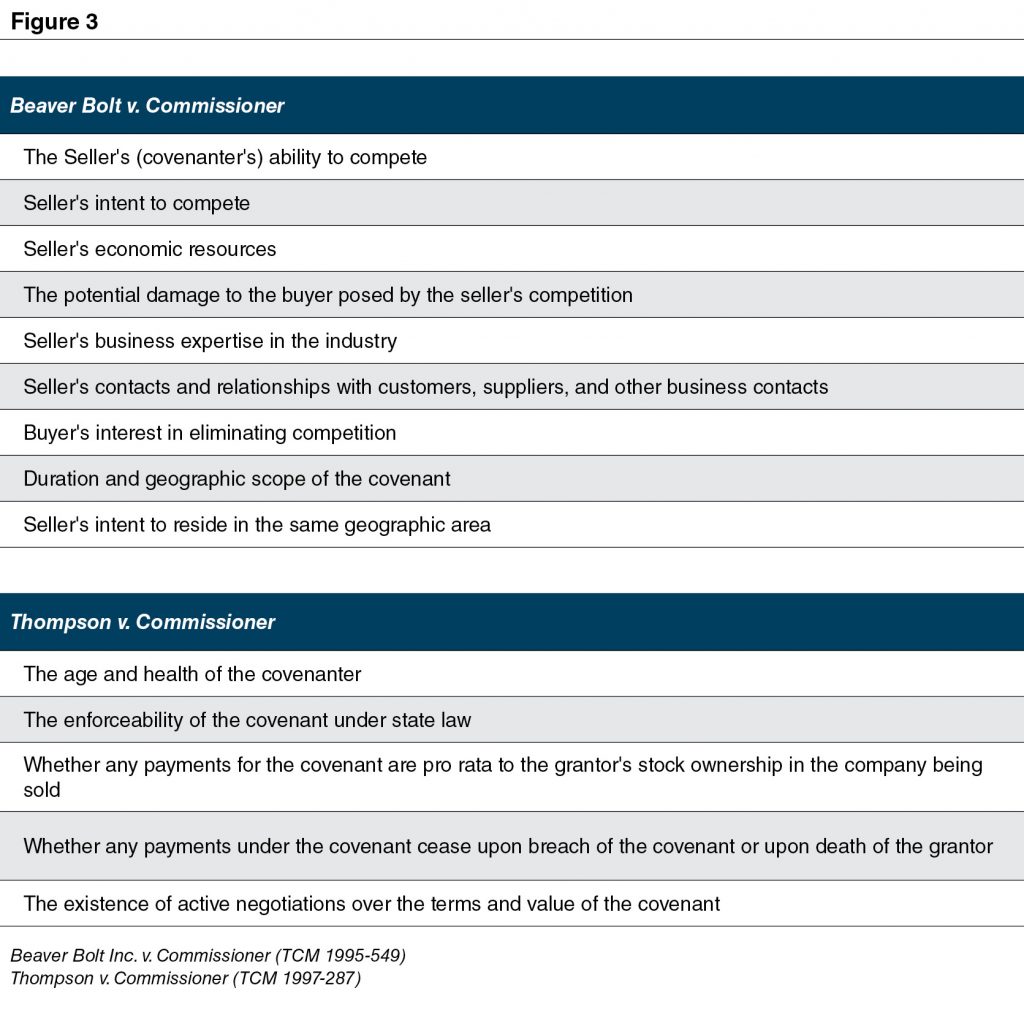
A common method to value noncompete agreements is the “with or without” method. Fundamentally, a noncompete agreement is only as valuable as the stream of cash flows the firm projects “with” an agreement compared to “without” one. The difference between the two projections effectively represents the “cost” of competition, or stated differently, the value of the cash flows protected by the noncompete agreement. Cash flow models can be used to assess the impact of competition on the firm based on the desire, ability, and feasibility of the executive to compete. Valuation professionals consider factors such as revenue reductions, increases in expenses, and the impact of employee solicitation and recruitment.
To illustrate how the three factors of Revenue Ruling 77-403 can be evaluated in light of the specific terms of a noncompete agreement for a bank employee, we put together Figure 4.
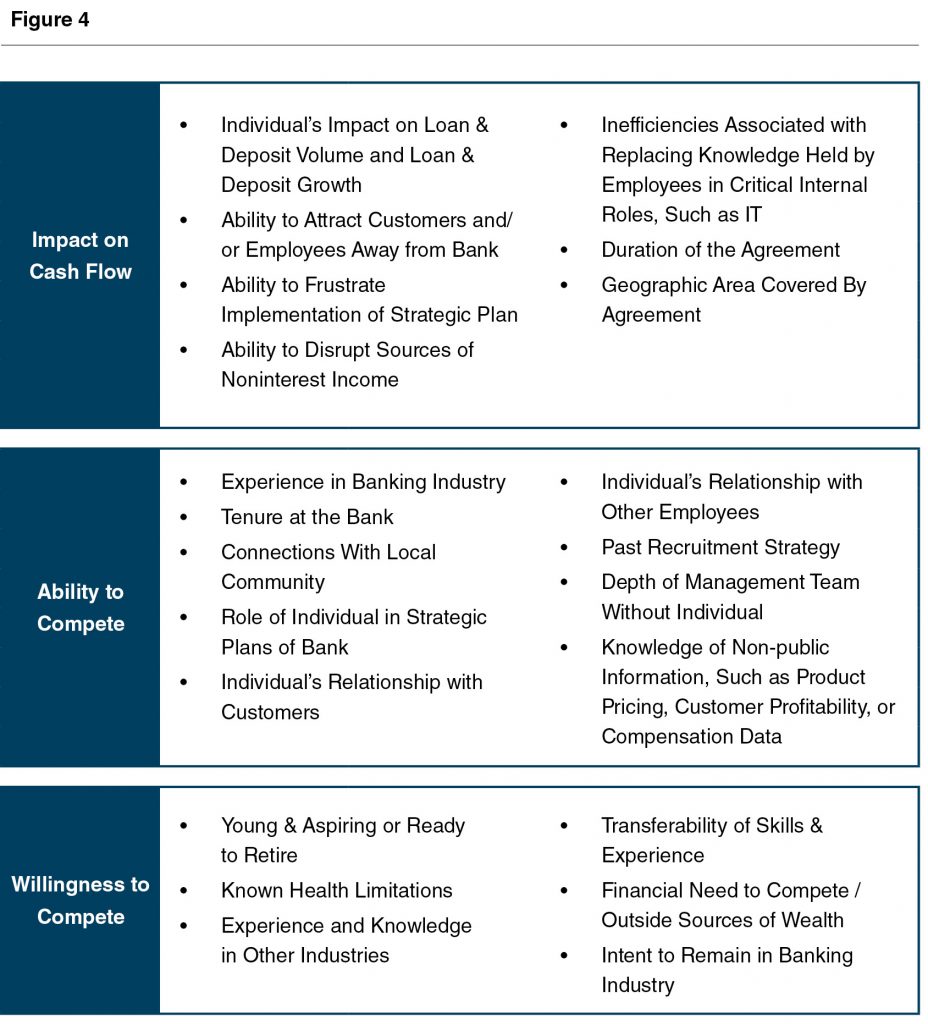
Mercer Capital provides independent valuation opinions to assist companies with IRC Section 280G compliance. Our opinions are well-reasoned and well-documented regarding the factors influencing the value of non-compete agreements.
6 Ways to Look at a Business
Along the road to building the value of a business it is necessary, and indeed, appropriate, to examine the business in a variety of ways. Each provides unique perspective and insight into how a business owner is proceeding along the path to grow the value of the business and if/when it may be ready to sell. Most business owners realize the obvious events that may require a formal valuation: potential sale/acquisition, shareholder dispute, death of a shareholder, gift/estate tax transfer of ownership, etc. A formal business valuation can also be very useful to a business owner when examining internal operations.
So, how does a business owner evaluate their business? And how can advisers or formal business valuations assist owners examining their businesses? There are at least six ways and they are important, regardless of the size of the business. All six of these should be contemplated within a formal business valuation.
- At a Point in Time. The balance sheet and the current period (month or quarter) provide one reference point. If that is the only reference point, however, one never has any real perspective on what is happening to the business.
- Relative to Itself over Time. Businesses exhibit trends in performance that can only be discerned and understood if examined over a period of time, often years.
- Relative to Peer Groups. Many industries have associations or consulting groups that publish industry statistics. These statistics provide a basis for comparing performance relative to companies like the subject company.
- Relative to Budget or Plan. Every company of any size should have a budget for the current year. The act of creating a budget forces management to make commitments about expected performance in light of a company’s position at the beginning of a year and its outlook in the context of its local economy, industry and/or the national economy. Setting a budget creates a commitment to achieve, which is critical to achievement. Most financial performance packages compare actual to budget for the current year.
- Relative to your Unique Potential. Every company has prospects for “potential performance” if things go right and if management performs. If a company has grown at 5% per year in sales and earnings for the last five years, that sounds good on its face. But what if the industry niche has been growing at 10% during that period?
- Relative to Regulatory Expectations or Requirements. Increasingly, companies in many industries are subject to regulations that impact the way business can be done or its profitability.
Why is it important to evaluate a company in these ways? Together, these six ways of examining a company provide a unique way for business owners and key managers to continuously reassess and adjust their performance to achieve optimal results.
A formal business valuation can communicate the company’s current position in many of these areas. Successive, frequent business valuations allow business owners and key managers the opportunity to measure and track the performance and value of the company over time against stated goals and objectives.
Originally published in Mercer Capital’s Tennessee Family Law Newsletter, Third Quarter 2018
How to Determine Whether an Asset and Its Appreciation is Marital or Separate Property
Under Tennessee law, marital property is subject to property division and separate property is excluded from property division in a divorce. The underlying factor in this distinction is whether the increase in value between the date of marriage and the date of divorce resulted from efforts by a spouse, known as active appreciation, or from external (economic, market, industry) forces, known as passive appreciation. While these concepts seem simple, the classifications are only part of the story.
Classification of Marital and Separate Property
Tennessee Code 36-4-121 defines marital property as “all real and personal property, both tangible and intangible, acquired by either or both spouses during the course of the marriage up to the date of the final divorce hearing.”
The same code section defines separate property as “all real and personal property owned by a spouse before marriage, property acquired in exchange for property acquired prior to marriage, property acquired by a spouse at any time by gift, bequest, devise or descent, etc.”
Can a Marital Asset Ever Become Separate or Can a Separate Asset Ever Become Martial?
Let’s examine this question in the context of a business or business interest as an example. If a couple or spouse starts a business or acquires a business interest during the marriage, then it would be classified as marital. Any appreciation or increase in value of the business or business interest would also be classified and remain a marital asset.
Conversely, if a spouse starts a business or business interest prior to the date of marriage or acquires it by gift, bequest, devise or descent, then initially that business or business interest would be classified as a separate asset. What happens to that business or business interest if the value changes during the marriage? The increased value or appreciation of a business or business interest could be classified as marital or separate. How is this possible?
If both spouses contribute to the preservation and appreciation of a separate property business or business interest and the contribution is “real” and “significant,” then the appreciation (increase in value) of the business or business interest would be determined to be a marital asset and subject to division. This is known as active appreciation.
If, on the other hand, both spouses do not contribute to the appreciation in value, there is no appreciation in value, or the appreciation is attributable to passive forces, such as inflation, then the separate property business or business interest would remain separate.
The following steps assist the financial analyst during the process:
- Is the business, or business interests, marital or separate?
-
- a. Compare the formation or inheritance date(s) to date of marriage.
-
- If the answer to (1) concludes pre-marital, separate property, value the business as of the date of marriage as a starting point. Then, value the business as of the date of divorce (or as close to as possible).
- If the value has increased from the date of marriage to the date of divorce, a determination of active (marital) versus passive (separate) shall commence.
What Must Be Demonstrated
Tennessee code states that the substantial contribution of the non-business spouse “may include, but not be limited to, the direct or indirect contribution of the spouse as a homemaker, wage earner, parent or financial manager, together with such other factors as the court having jurisdiction thereof may determine.”
A non-business owner spouse must be able to demonstrate two things in order for appreciation of a separate property business or business interest to become a marital asset: substantial contribution of both spouses contributing to the appreciation,and actual appreciation in the value of the business or business interest during the marriage. Most often, a valuation of the business or business interest at the date of marriage and also the date of filing would be required among other things to try and support this claim.
This article has used a business or business interest to illustrate the concepts of martial vs. separate assets and also the appreciation in value. It should be noted that there could be potentially other considerations for these same issues with other assets, such as investment properties or passive assets (401Ks, etc.).
Conclusion
A financial expert, specifically one with expertise in business valuation, is vital in the determination of active appreciation (separate) versus passive appreciation (marital).
The professionals of Mercer Capital can assist in the process. For more information or discuss an engagement in confidence, please contact us.
Originally published in Mercer Capital’s Tennessee Family Law Newsletter, Third Quarter 2018
Pro Sports Player Contract Valuations And The New Tax Law
Download Article
The change in the tax law brings additional attention to player contract values as they are now potentially taxable events for teams.
As the 2018 calendar year moves towards a close, front offices and league offices across professional sports are at different places:
- MLB just finished their year, and teams are taking stock of what happened and planning for winter meetings.
- MLS is a few weeks away from the MLS Cup in early December.
- The NFL is just past the halfway point as the trade deadline recently past and the playoff race is being run.
- The NBA and NHL are getting their seasons off the ground and haven’t hit the quarter pole yet.
Players are at the heart of all these leagues. Whether a rookie, veteran, all-star, or benchwarmer, these players all have value. Now, as a result of the Tax Cuts and Jobs Act, exactly how much value is a very real question for many player contracts involved in a trade, adding complexity to an already complicated process.
Beginning in 2018, the tax treatment for certain player-for-player trades changed. Player-for-player trades have been treated as a like-kind exchange for decades. However, the appreciation in value of a traded player’s contract has now potentially become a taxable event for teams. Considering this, when a taxable event occurs, teams must measure this appreciation in terms of dollars in order to report potential capital gains to the IRS. This is where valuation issues become relevant.
Contract Valuations: The CFO’s Domain Is Now Merging With Team Operations
As important as they are to a sports team, historically player contracts rarely needed to be separately valued. When they did, it was typically when a franchise was bought or sold. In that situation, player contracts (along with other identified intangibles) were allocated as an asset in the purchase price.
Franchise transitions happen relatively infrequently; therefore, some front offices, tax advisors, and valuation firms don’t have experience in this area. Mercer Capital is one of very few with deep experience in this area.
Historically, general managers and personnel departments valued player contracts internally which produced a relative valuation result. This value result cannot now be directly used by the tax and finance department to report values. Therefore, it’s important to work with professionals who have experience determining the fair market value of player contracts and understand the complexities of each league.
Trades are usually made for (i) other players, (ii) draft pick rights, (iii) cash, or a combination of these. When analyzing the trade deal, only one scenario would appear to directly value player contracts – a cash deal. However, even this can be somewhat deceiving when it comes to fair market value as player development and other hidden costs may need to be included. Indeed, draft picks and draft positioning function as a currency in leagues, especially the NFL with larger rosters and shorter playing careers. Trades and player values are often discussed in terms of relative draft pick positioning.
Other factors can come into play as well. What if the teams involved in a trade had rationale for it not directly related to contract value, like salary cap issues? The fair market value of a contract could be only one of many issues at play in a trade under various scenarios.
Therefore, when determining a player contract’s fair market value, it’s important to have a valuation methodology that comports with a team’s internal rationale, as well as having IRS supportability.
Valuation Approaches And Considerations
Numerous factors impact the fair market value of a player contract, including:
- Historical performance
- Potential future performance
- Position played
- Commercial and media potential
- Off-field behavior
- Age Physical characteristics
- Roster and league attrition
- Draft position
- Team performance and constitution
- Length of existing contract
- Other
Valuation Approaches
There are three approaches to value that could potentially capture the above factors into a single dollar figure: income, market, and cost approaches. The income approach is rarely used because it is difficult to directly trace an individual player’s impact on the team’s income stream. The market approach and the cost approach, or a hybrid of the two, are more typically employed to value player contracts.
Valuation Considerations
Due to the nature of the asset, a mix of quantitative and qualitative analyses are used to develop a model to value player contracts and the economic benefit (or detriment) they possess relative to the rest of the team’s roster. This is done in comparison to alternatives that a team may have and a player may have under their collective bargaining agreement. Once adjustments are made, a value can be estimated. A hybrid method using both the market and cost approach has the following benefits:
- Data driven
- Consistent
- Tethered to the framework of a league’s collective bargaining agreement
- Can ascribe value to draft pick rights as well as player contracts
Of course, values are subject to facts and circumstances. Potential differences in opinions on either side of a trade is an issue that is likely to arise. If teams cannot agree to a value, or appraisals of the same player contract result in different values, there is the potential of an IRS audit situation for both teams on the same trade.
Conclusion
The change in the tax law brings additional attention to player contract values. It may or may not impact how a team approaches its business of winning championships, but it will impact how leagues and front offices approach valuations of player contracts. Will the leagues, taxpayers, and the IRS find common ground? Perhaps it will depend on how touchdowns, goals, hits, and rebounds translate into value on a tax return.
Valuation Tax Panel
This presentation was delivered by Z. Christopher Mercer, FASA, CFA, ABAR at the AICPA 2018 Forensic & Valuation Services Conference.
A short description of the presentation can be found below:
How substantial is tax reform’s effect on business valuation? There has been a lot of discussion and interest in the new TCJA especially, but how has this changed the way we think about valuation. The panel will discuss different views on tax reform related to valuation modeling, forecasting, and subjective assumptions used when considering the TCJA.
Learning objectives include:
- Understand the various implications of the TCJA on pass through entity valuations
- Explore the effect on public company and transaction multiples post TCJA
- Review best practices with model considerations in light of sunset provisions
- Learn the effect of bonus depreciation and interest expense limitations
Active Passive Appreciation – Current Update
This presentation, delivered by Z. Christopher Mercer, FASA, CFA, ABAR at the AICPA 2018 Forensic & Valuation Services Conference, covers when and why an active passive analysis is needed, how these analyses are typically done, and the importance of working with engaging counsel for jurisdictional nuances.
Learning objectives include:
- Understand the key elements involved in an active passive analysis
- Update of current practice and understand how active passive analyses are typically done around the country
- Discussion of jurisdictional nuances
Views from the Road: What Do Community Banks, FinTech, and Buffalo Have in Common?
In the last few weeks, I presented at two events geared towards helping community banks achieve better performance: the Moss Adams Community Banking Conference in Huntington Beach, California and the FI FinTech Unconference in Fredericksburg, Texas. The FI FinTech Unconference had a recurring visual theme of the buffalo, which struck me as an insightful image for a FinTech conference.
Much of the discussions at both conferences focused on the ability of community banks to adapt, survive, and thrive rather than thin out like the once massive North American buffalo herd. Both events had several presentations and discussions around FinTech and the need for community banks to evolve to meet customer expectations for improved digital interactions. Beyond thinking that I will miss the great views and weather I had for both trips, I came away with a few questions bankers should consider.
How Can Community Banks Compete with Larger Banks?
Larger banks are taking market share from smaller banks and have been gathering assets and deposits at a faster pace than community banks (defined as banks with less than $10 billion of assets) the last few decades. For example, banks with assets greater than $10 billion controlled around 85% of assets in mid-2018 compared to 50% in 1994. This is a significant trend illustrating how much market share community banks have ceded. Further, larger banks are producing higher ROEs, largely driven by higher levels of non-interest income (~0.90% of assets vs ~0.55%) and better operating leverage as measured by the efficiency ratio (~59% vs ~66%). The larger banks may widen their lead, too, given vast sums that are being spent on digital enhancements and other technology ventures to improve the client experience.
Can FinTech Serve as a Value Enhancer and Help Community Banks Close the Performance Gap with Larger Banks?
Most community banks are producing an ROE below 10%—an inadequate return for shareholders despite low credit costs. As a result, the critical role that a community bank fills as a lender to small business and agriculture is at risk if the board and/or shareholders decide to sell due to inadequate returns. Confronting this challenge requires the right team executing the right strategy to produce competitive returns for shareholders. FinTech solutions, rather than geographic expansion through branching and acquisitions, may be an option if FinTech products and processes can address areas where a bank falls short (e.g., wealth management).
Can Community Banks Hold Ground and Even Win the Fight for Retail Deposits?
Many community bank cost structures are wed to physical branches while customers— especially younger ones—are increasingly interacting with institutions first digitally and secondarily via a physical location. This transition is occurring at a time when core deposits are increasing in value to the industry as interest rates rise. In response, several larger banks, such as Citizens Financial, have increased their emphasis on digital delivery to drive incremental deposit growth. Additionally, as funding costs increase, some FinTech companies are being forced to consider partnerships with banks. Thus far, the digital banking push and the formal partnering of FinTech companies and banks are incremental in nature rather than reflective of a wholesale change in business models. Nonetheless, it will be interesting to see whether community banks can adapt and effectively use technology and FinTech partnerships to compete and win retail deposit relationships in a meaningful way.
How Can Community Banks Develop a FinTech Framework?
Against this backdrop, I see four primary steps to developing a FinTech framework:
- Identify attractive FinTech niches such as deposits, payments, digital lending, wealth management, insurance, or efficiency (i.e., tech initiatives designed to reduce costs)
- Identify attractive FinTech companies in those niches
- Develop a business case for different strategies (estimate the Internal Rates of Returns and IRRs)
- Compare the different strategies and execute the optimal strategy
What Are Some Immediate Steps that Banks Can Take Regarding FinTech?
The things that banks can do right now to explore FinTech opportunities are:
- Get educated. There are an increasing number of events for community bankers incorporating FinTech into their agenda and we have a number of resources on the topic as well
- Begin or continue to integrate FinTech into your strategic plan
- Determine what your customers want/need/expect in terms of digital offerings
- Seek out FinTech partners that provide solutions and begin due diligence discussions
How Mercer Capital Can Help
Mercer Capital can help your bank craft a comprehensive value creation strategy that properly aligns your business, financial, and investor strategies. Given the growing importance of FinTech solutions to the banking sector, a sound value creation strategy needs to incorporate FinTech.
We provide board/management retreats to educate you about the opportunities and challenges of FinTech for your institution. We can:
- Help your bank identify which FinTech niches may be most appropriate for your bank given your existing market opportunities
- Help your bank identify which FinTech companies may offer the greatest potential as partners for your bank
- Help provide assistance with valuations should your bank elect to consider investments or acquisitions of FinTech companies
We are happy to help. Contact us at 901.685.2120 to discuss your needs.
Originally published in Bank Watch, October 2018.
Intrinsic Value and Valuation Multiples
This presentation, originally delivered by Z. Christopher Mercer, FASA, CFA, ABAR at the Fairfax Bar Association’s Annual Conference in October 2018, discusses the intrinsic value standard of value in Virginia divorce-related valuations of closely held business assets. Additionally, this presentation also covers developing valuation multiples with credibility.
Accounting Standards Update 2016-01: Impairment Considerations for Equity Investments
ASU 2016-01 shook up financial reporting at the beginning of the year, as companies scrambled to determine compliance with the new requirements for reporting equity investments.
The rise of corporate venture capital over recent years largely flew under the accounting radar until this update took effect, creating significant volatility for many corporate investors in their reported earnings as they were required to recognize the gains and losses from investments previously held at cost.
Now that the initial shock has worn off, CFOs may be able to rest a little easier, but they shouldn’t forget about the requirements under ASU 2016-01 entirely.
Even if the company elected the measurement alternative that allows for the investment to be reported at cost, don’t forget about the requirement for impairment testing that goes along with it. Some companies may choose to perform the initial Step Zero analysis internally before engaging a valuation firm to navigate the rest of the process, while others turn over the entire process to a valuation professional.
“An entity may elect to measure an equity security without a readily determinable fair value [and that does not qualify for the practical expedient]…at its cost minus impairment, if any, plus or minus changes resulting from observable price changes in orderly transactions for the identical or a similar investment of the same issuer.”
ASU 2016-01 Paragraph 321-10-35-2
Originally appeared in Mercer Capital’s Financial Reporting Update: Goodwill Impairment
Industry Considerations for Step Zero: Qualitative Assessments
What is Step Zero?
A qualitative approach to test goodwill for impairment was introduced by the Financial Accounting Standards Board (“FASB”) when it released Accounting Standards Update 2011-08 (“ASU 2011-08”) in September 2011 as an update to goodwill impairment testing standards under Topic 350, Intangibles—Goodwill and Other. ASU 2011-08 set forth guidance for an optional qualitative assessment to be performed before the traditional quantitative two step goodwill impairment testing process. This preliminary qualitative assessment is known as “Step Zero.” The goal of Step Zero is to simplify and reduce costs of performing the traditional quantitative goodwill impairment test process.
According to ASU 2011-08, Step Zero allows entities “the option to first assess qualitative factors to determine whether the existence of events or circumstances leads to a determination that it is more likely than not that the fair value of a reporting unit is less than its carrying amount.”
Step One is required only if the qualitative assessment supports the conclusion that it is more likely than not (i.e., likelihood greater than 50%) that the fair value is less than the carrying value. Otherwise, Step One of the goodwill impairment testing process is not required. Alternatively, Step Zero can be skipped altogether, and the traditional quantitative goodwill impairment test can be performed beginning with Step One.
Industry Considerations
The standards update release by FASB outlines the individual qualitative categories of the assessment. Specific qualitative events and circumstances to be evaluated include the economy, industry, cost factors, financial performance, firm-specific events, reporting unit events, and changes in share price.
ASU 2011-08 defines industry events and circumstances as follows:
“Industry and market conditions such as a deterioration in the environment in which an entity operates, an increased competitive environment, a decline in market-dependent multiples or metrics (consider in both absolute terms and relative to peers), a change in the market for an entity’s products or services, or a regulatory or political development.”
The process of evaluating an industry involves assessing each of these stated events and circumstances since the previous reporting period and determining how they affect the comparison of fair value to carrying value. By comparing current conditions to the prior period, an analysis of relative improvement or deterioration can be made concerning each industry factor and the industry as a whole.
Increasing multiples, share prices, financial metrics, and M&A activity indicate that an industry is improving and suggests that it is more likely than not that the reporting unit’s fair value is greater than its carrying value. Decreasing multiples, share prices, financial metrics, and M&A activity indicate the industry is weakening and suggests that fair value may be less than the reporting unit’s carrying value.
Industry Analysis
An analysis of the S&P 1500, an index that includes approximately 90% of the market capitalization of U.S. stocks, reveals the prevalence of impairment in different industries. For example, of the companies reporting goodwill on their balance sheets, 25% of telecommunication, 17% of consumer staples, and 14% of consumer discretionary companies recorded goodwill impairment charges in 2017.
On the other hand, the more robust performance of financial, information technology, and real estate companies is manifest in that only 4% of companies reporting goodwill in each industry recorded a goodwill impairment charge in 2017.
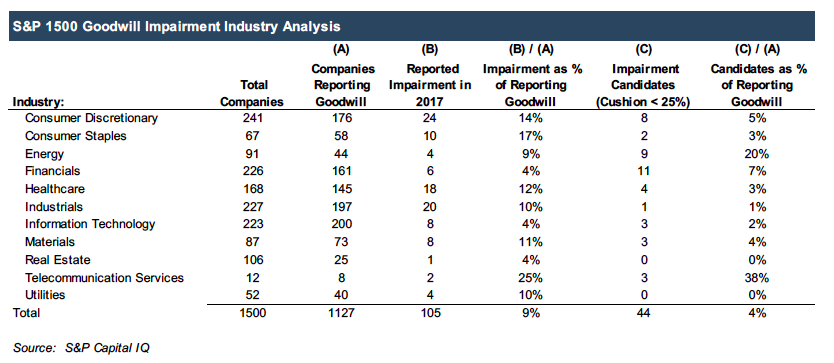
Further analysis indicates that companies in the energy and telecommunication industries are currently more likely to be potential impairment candidates as 20% and 38%, respectively, of companies reporting goodwill have cushions (the amount by which market value of equity exceeds book value of equity) of less than 25%. Deterioration in the operating environment of these industries may result in an increase in goodwill impairment charges. Industries with fewer impairment candidates at the moment include real estate, utilities, and industrials.
Industry considerations are particularly important to the qualitative assessment and provide valuable insight on the potential for impairment. The qualitative assessment is especially valuable in industries that are performing well as it is less likely that goodwill is impaired.
Step Zero provides the opportunity to perform a preliminary qualitative analysis to determine the necessity of performing the traditional two step goodwill impairment test and can lead to a simpler, more efficient impairment testing process.
The analysts at Mercer Capital have experience in, and follow, a diverse set of industries. We help clients assemble, evaluate, and document relevant evidence for the Step Zero impairment test. Call us today so we can help you.
Originally appeared in Mercer Capital’s Financial Reporting Update: Goodwill Impairment
Tax Reform and Impairment Testing
Earlier this year, we considered the impact of the Tax Cuts and Jobs Act of 2017 (“TCJA”) on purchase price allocations. In this article, we turn our focus to the impact of the TCJA on goodwill impairment testing. Changes to the tax code will affect both the qualitative assessment (often referred to as Step Zero) and quantitative impairment test.
Qualitative Assessment
Companies preparing a qualitative assessment are required to assess “relevant events and circumstances” to evaluate whether it is more likely than not that goodwill is impaired. ASC 350 includes a list of eight such potential events and circumstances.
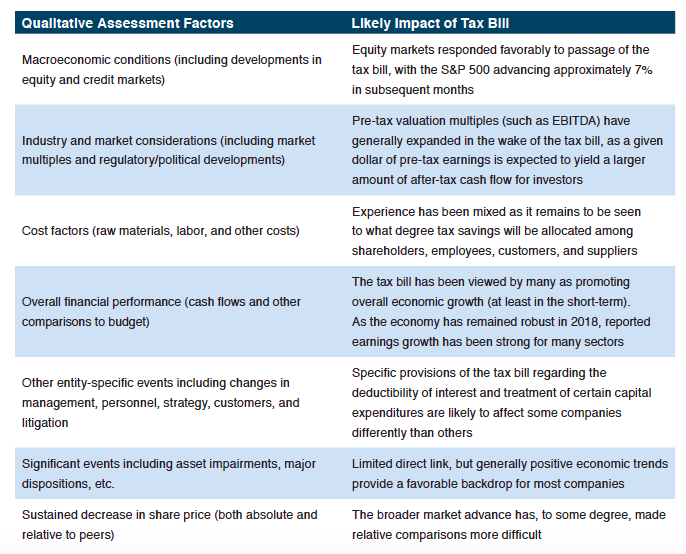
Quantitative Assessment
The same features which, on balance, have made it more likely that reporting units will garner a favorable qualitative assessment also contribute to the fair value of reporting units under the quantitative assessment.
- Reduction in income tax rate. All else equal, a reduction in the applicable federal income tax rate from 35% to 21% increases after-tax cash flows and contributes to higher fair values for reporting units.
- Bonus depreciation provisions. The tax bill allows certain capital expenditures to be deducted immediately for purposes of calculating taxable income. While the aggregate amount of depreciation deductions is unaffected, the acceleration of the timing of tax benefits can have a marginally positive effect on the fair value of some reporting units.
- Interest deduction limitations. One potentially negative effect of the tax bill on reporting unit fair values is the limitation on the amount of interest expense that is deductible for tax purposes. For some highly-leveraged businesses, the interest deduction limitation can increase the weighted
average cost of capital. We expect the interest deduction limitations to adversely affect only a small minority of companies. - Increase in after-tax cost of debt. When calculating the cost of debt as a component of the cost of capital, analysts multiply the pre-tax cost of debt by one minus the corporate tax rate. The new lower tax rate will, therefore, cause the after-tax cost of debt to increase by a small increment. All else equal, an increase to the weighted average cost of capital has a negative impact on the fair value of a reporting unit. On balance, we expect the negative effect from higher costs of capital to be smaller than the positive cash flow effect from lower tax rates.
Conclusion
The Tax Cuts and Jobs Act of 2017 is a material factor to be considered in both qualitative and quantitative assessments of goodwill impairment in 2018. While the provisions are not uniformly favorable to higher valuations, the balance of factors suggests that goodwill impairments will be less likely in the coming impairment cycle. To discuss how the new tax regime affects your company’s goodwill impairment more specifically, please give one of our professionals a call.
Originally appeared in Mercer Capital’s Financial Reporting Update: Goodwill Impairment
What is the Order of Testing for Impairment?
When testing the goodwill of a reporting unit for impairment, the order of operations matters. Because the units themselves may contain assets subject to impairment testing, it is important to first reflect accurate carrying values for those assets before testing the goodwill of the unit overall.
If the goodwill of the unit is tested before a write down of certain of its assets occurs, there may be increased risk of inaccurately allocating impairment between the assets and goodwill of the unit. Similarly, failing to address the order of testing could lead to the false conclusion that the goodwill of a reporting unit is impaired, when there is really only impairment of its underlying identifiable assets. These errors occur when the unit’s fair value of goodwill is compared to an inaccurately high carrying value that results from failing to adjust asset values first.
According to the AICPA Accounting & Valuation Guide: Testing Goodwill for Impairment [paragraph 2.57], the order of impairment testing should be as follows:
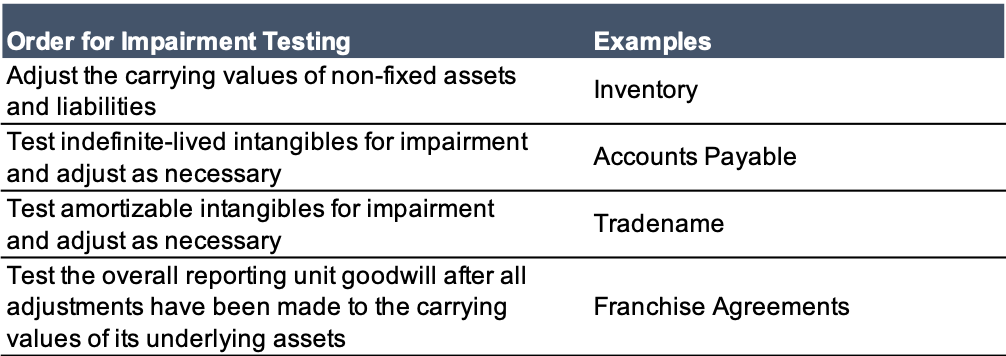
Financial statement preparers should not neglect the proper order of impairment testing to ensure current allocation of impairment.
Originally appeared in Mercer Capital’s Financial Reporting Update: Goodwill Impairment
Financial Reporting Fallacy: The Whole May Appear Healthier Than the Parts
A logical fallacy occurs when one makes an error in reasoning. Causal fallacies occur when a conclusion about a cause is reached without enough evidence to do so. The cum hoc (“with this”) fallacy is committed when a causal relationship is assumed because two events occur together.
When it comes to financial reporting, an example of this fallacy would be assuming that goodwill cannot be impaired unless the company’s shares are trading below book value. This is a tempting fallacy–especially as the U.S. economy is continuing a long expansion, companies are posting solid earnings, and valuations are reaching new highs. The S&P 500 increased 19% in 2017 and the Nasdaq was up 28%. In these market conditions, goodwill impairment probably does not seem like a pressing concern. After all, goodwill is considered impaired only when fair value drops below carrying value, right? While this is true, accounting standards require that goodwill be tested for impairment at the reporting unit level. Impairment relates to a reporting unit’s ability to generate cash flows. This means that a company’s goodwill can be impaired at the reporting unit level, even as its stock trades above book value.
This was the case for multinational conglomerate General Electric last year. GE had a tumultuous 2017 as the company’s CEO and CFO departed, the dividend was cut, and a corporate restructuring was announced. The salient event for the purposes of this article is a $947 million impairment loss recorded in its Power Conversion Unit during the third quarter of 2017. This unit is what became of GE’s 2011 $3.2 billion acquisition of Converteam, an electrical engineering company. According to the company’s 2017 annual report, the causes for this impairment included downturns in marine and oil and gas markets, pricing and cost pressures, and increased competition. GE’s stock felt the turmoil, falling 42% in 2017. Shares traded at $17.25 at their lowest point, implying a market capitalization of $150.5 billion. But even at this point, GE’s stock was not trading below book value ($64.3 billion at the end of 2017). GE’s market value exceeded book value of equity by $86.2 billion. So while impairment and market value/share price are related, it is not safe to assume that there is no impairment if the stock trades above book value.

Another notable example is CVS Health. The company made headlines with one of the largest mergers of the year when it announced the acquisition of insurer Aetna, Inc. for $69 billion in December 2017. A smaller, less widely reported transaction transpired in November when the company announced the sale of its RxCrossroads reporting unit to McKesson Corp. for $735 million. This unit was part of CVS’s 2015 acquisition of nursing home pharmacy Omnicare, Inc. and provided reimbursement assistance and sales operation support, among other services. In the second quarter of 2017, CVS recognized a $135 million impairment charge related to this reporting unit. As with GE, CVS never traded below book value. CVS stock declined approximately 8% in 2017 and hit a low of $66.45 on November 6. The market capitalization at this point was approximately $67.7 billion. The book value of CVS equity was $34.9 billion at September 30, 2017 and
$37.7 billion at year-end.
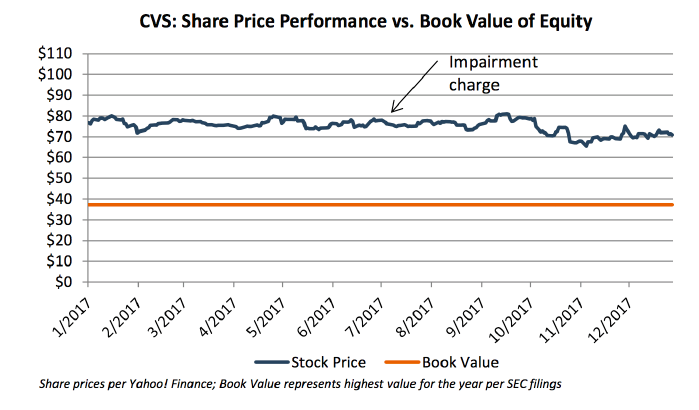
The above examples expose the fallacious idea that a company can avoid impairment charges simply because its stock trades above book value. That is not to say that there is no relationship between the two; an impairment charge can certainly signal the market and affect share price, or a decline in share price may foreshadow an impending impairment charge. Because goodwill must be tested for impairment at the reporting unit level, impairment may occur even when the company’s market cap exceeds book value.
Originally appeared in Mercer Capital’s Financial Reporting Update: Goodwill Impairment
The 12 Questions That Keep Family Business Directors Awake at Night
The intersection of family and business generates a unique set of questions for family business directors. We’ve culled through our years of experience working with family businesses of every shape and size to identify the twelve questions that are most likely to trigger sleepless nights for directors. Those questions are:
- How Do We Promote Positive Shareholder Engagement?
- How Do We Communicate More Effectively with Shareholders?
- Does Our Dividend Policy Fit?
- To Invest or Not to Invest?
- Should We Diversify?
- Does Father Always Know Best?
- How Do We Find Our Next Leader?
- Is There a Ticking Time Bomb Lurking in Our Family Business?
- What Is the Family’s Most Valuable Asset?
- What Should We Do About Estate Taxes?
- How Should We Respond to an Acquisition Offer?
- Who’s In and Who’s Out?
The 12 Questions That Keep Family Business Directors Awake at Night summarizes some of our thoughts, experiences, and insights around each question and suggests possible next steps.
Perhaps more importantly, though, it is an invitation to join our ongoing conversation about the questions family business directors need to think about. That conversation continues on our blog, Family Business Director, where we explore these and other topics of interest to family business directors.
Mercer Capital provides sophisticated financial advisory services to family businesses, including:
- Advisory services for family business directors
- Financial consulting services for family business managers
- Independent valuation opinions
- Transaction advisory services
- Confidential shareholder surveys
- Benchmarking / business intelligence services
- Shareholder engagement support
- Shareholder communication support
Automobile Dealership Valuation 101
Valuation of a business can be a complex process requiring certified business valuation and/or forensic accounting professionals. Valuations of automobile dealerships are unique even from valuation of manufacturing, service, and retail companies. Automobile dealership valuations involve the understanding of industry terminology, factory financial statements, and hybrid valuation approaches. For these reasons, it’s important to hire a business valuation expert that specializes in automobile dealership valuation and not just a generalist business valuation appraiser.
Terminology
Blue Sky
Unlike most valuations used in the corporate or M&A world, cash flow metrics such as Earnings Before Interest, Taxes, and Depreciation (“EBITDA”) are virtually meaningless in automobile dealership valuations. Instead, this industry communicates value in terms of Blue Sky value and Blue Sky multiples. What is Blue Sky value? Any intangible/goodwill value of the automobile dealership over/above the tangible book value of the hard assets is referred to as Blue Sky value. Typically, Blue Sky value is measured as a multiple of pre-tax earnings, referred to as a Blue Sky multiple. Blue Sky multiples vary by franchise/brand and fluctuate year-to-year.
Dealer Financial Statements
Another unique aspect of automobile dealership valuations is the reported financial statements. Unlike valuations in other industries where the preferred form of financial statements might be audited/compiled or reviewed financial statements, most reputable valuations of automobile dealerships rely upon the financial statements that each dealer reports to the franchise/factory, referred to as Dealer Financial Statements. Why are Dealer Financial statements preferred? Dealer Financial statements provide much more detailed information pertaining directly to the operations of the dealership than any audited financial statement. Valuable information includes the specific operations and profitability of the various departments including, new vehicle, used vehicle, parts and service, and finance and insurance. Each department is unique and has a different impact on the overall success and profitability of the entire dealership. Automobile dealerships are required to report these financial statements to the factory on a monthly basis. However, an experienced business valuation expert knows to request the 13th month dealer financial statements. If a year only has twelve months, then what are the 13th month dealer financial statements? The 13th month dealer financials typically include the year-end tax adjustments such as adjusting the value of new/used vehicles to fair market value by reflecting current depreciation and other adjustments.
Valuation Approaches
Asset-Based Approach
The asset-based approach is a general way of determining a value indication of a business or a business ownership interest using one or more methods based on the value of the assets net of liabilities. Asset-based valuation methods include those methods that seek to adjust the various tangible and intangible assets of an enterprise to fair market value. In automobile dealership valuations, the asset method is utilized to establish the fair market value of the tangible assets. This value is then combined with a Blue Sky “market” approach to conclude the total fair market value of the automobile dealership.
Income Approach
The income approach is a general way of determining a value indication of a business or business ownership interest using one or more methods that convert anticipated economic benefits into a single present amount.
The income approach can be applied in several different ways. Valuation methods under the income approach include those methods that provide for the direct capitalization of earnings estimates, as well as valuation methods calling for the forecasting of future benefits (earnings or cash flows) and then discounting those benefits to the present at an appropriate discount rate. The income approach allows for the consideration of characteristics specific to the subject business, such as its level of risk and its growth prospects relative to the market.
How is the income approach unique to the automobile dealership industry? First, projections are rarely produced or tracked by automobile dealers, so historical capitalization methods are mostly used. Second, most automobile dealerships are dependent on the national economy, and sometimes to a larger degree, their local economies. This is important because business appraisers need to analyze and understand the dependence of each dealership to the national and local economy which usually affects the seasonality/cyclicality of operations and profitability. Once again the automobile dealership is unique in that it can experience seasonal/cyclical fluctuation in a given year, or more importantly, it fluctuates over a longer period of more like five-to-seven years.
Market Approach
The market approach is a general way of determining the value indication of a business or business ownership interest by using one or more methods that compare the subject to similar businesses, business ownership interests, securities, or intangible assets that have been sold.
Market methods include a variety of methods that compare the subject with transactions involving similar investments, including publicly traded guideline companies and sales involving controlling interests in public or private guideline companies. Consideration of prior transactions in interests of a valuation subject is also a method under the market approach.
In the automobile dealership industry, traditional market approaches are basically meaningless. While there are a few publicly traded companies in the industry, they are large consolidators and own numerous dealership locations of many franchises in many geographic areas. Private transactions exist, but generally not in a large enough sample size of the particular franchise to provide meaningful comparisons.
So, how does a business valuation expert utilize the market approach in the valuation of automobile dealerships? The answer is a hybrid method utilizing published Blue Sky multiples from transactions of various franchise dealership locations. Two primary national sources, Haig Partners and Kerrigan Advisors, publish Blue Sky multiples quarterly by franchise. As discussed earlier, these multiples are applied to pre-tax earnings and indicate the Blue Sky or intangible value of the dealership. When combined with the tangible value of the hard assets determined under the Asset Approach, an experienced business valuation expert is able to conclude a total value for the dealership using this hybrid approach and communicate that result as a multiple of Blue Sky that will be understood and accepted in the industry.
Normalizing Adjustments
Normalizing adjustments adjust the balance sheet and income statement of a private company to show the financial results from normal operations of the business and reveal a “public equivalent” income stream. Some typical areas of potential normalization adjustments in the automobile dealership industry include, but are not limited, to the following.
Inventories
Most dealerships report the value of their new and used vehicle inventories on a Last-In, First-Out (“LIFO”) basis. LIFO accounting allows the dealership to reduce the value of their inventories and pay fewer taxes. General valuation theory calls for inventories to be restated at First-In, First-Out (“FIFO”) basis. The FIFO adjustments affect both the balance sheet and the income statement. The inventory adjustment on the balance sheet generally raises the value of the inventory. On the income statement, the inventory adjustment affects the cost of goods sold, and ultimately, the gross profit margin.
Officer/Dealer Compensation
Like all valuations, the compensation of the officer/dealer is important. Typically, a business valuation expert will review actual compensation paid and determine a replacement or market equivalent compensation level.
Rent
Most automobile dealership entities contain the operations of the dealership only and not the underlying real estate. Typically, the underlying real estate is owned by the dealer in a related entity. As such, the dealership pays rent to the related party entity. It’s important for the business valuation expert to determine if the rental rate paid is equivalent with a market rental rate. Often, this rental rate is set to create additional profitability at either the dealership entity or the real estate entity.
Working Capital
Most factory dealer financial statements list the dealership’s actual working capital, along with the requirements from the factory. It’s important for the business valuation expert to assess whether the dealership has adequate working capital, or perhaps an excess or deficiency.
Fixed Assets
As discussed earlier, most dealerships do not own the underlying real estate. In those cases, most dealerships still report some cost value of land or leasehold improvements on their factory dealer financial statements.
It’s important for the business valuation expert to determine who owns the real estate, and if not owned by the dealership, the value of the land and leasehold improvements needs to be adjusted, reflecting the true value of the tangible assets of the dealership.
Failure to properly assess and make this adjustment will skew the implied Blue Sky multiple on the concluded value for the dealership.
Other Income Items
Most factory dealer financial statements have a line item on the income statement for other income items/additions. This category can be a sizeable number for a dealership depending on its sales volume and level of profitability. The business valuation expert should determine the items that comprise this category and how likely they are to continue at historical levels.
Some common items that appear in this category include factory dealer incentives on sales volume levels for vehicles, factory dealer incentives for service performance, document/preparation fees on the sale of new and used vehicles, and additional costs for financing and other services sold as a part of the vehicle transaction referred to as PACKs.
Conclusion
The valuation of automobile dealerships can be more complex than other valuations due to their unique financial statements, varying cost structures and profitability of departments, different terminology, and hybrid valuation methods.
Hiring a business valuation expert that specializes in this industry rather than a generalist business valuation appraiser can make all the difference in providing a reasonable valuation conclusion.
Originally published in the Value Focus: Auto Dealer Industry Newsletter, Year-End 2017.
eSports: Business Models
How an eSports Team Makes Money
An eSports team can make money in a variety of ways, including broadcast revenue, sponsorships, merchandise sales, and subscriptions. The sources of revenue are detailed below.
Sponsorships
As shown in the chart above, sponsorships and advertising account for the bulk of revenue for eSports. According to Patrik Sättermon (Fnatic’s Chief Gaming Officer), “[I]t is estimated that around 95% of the money generated by our eSports teams comes directly from sponsorship deals.” The novelty of eSports has attracted many well-known sponsors; however, teams have struggled to make sponsorships a sustainable source of revenue. The relatively short life of popular games proves to be an impediment to sustained sponsorship. A game might be highly popular currently but within a year fade from public interest.
IT/Computer related sponsorships are the most common in the eSports industry as gaming equipment and accessories are prominently displayed during events. For example, HP and Intel agreed to sponsor Activision Blizzard’s Overwatch League. As part of the agreement, competitors will exclusively use HP’s OMEN gaming PCs and displays.
From a valuation perspective, consistent recurring revenue is a benefit to the value of a company. Sponsorships can provide long-term recurring revenue to an eSports teams.
Broadcast Revenue
eSports broadcasting on TV is still in its infancy as broadcasters look for eSports content that will appeal to their target demographics. ELEAGUE, an eSports content and live tournament brand, has a broadcasting deal with TBS that shows Street Fighter V and Counter Strike: Global Offensive (“CS:GO”) on TV. The recently formed Overwatch League (“OWL”), will be broadcast on the ESPN, Disney, and ABC family of networks. Perhaps most importantly, a broadcast TV deal does not cancel existing distribution agreements such as broadcasts on Twitch that were already in place.
While game developers and league creators are able to come to broadcast agreements, it is more difficult for eSports teams. eSports teams generally do not share in broadcast revenues as those agreements are negotiated between game developers/league creators and the broadcasting entities.
Merchandise Sales
As mentioned in our eSports industry overview, consumer spending on eSports merchandise remains relatively low. eSports teams offer apparel, accessories, and gaming equipment through their team websites. From a valuation perspective, merchandise sales can be a source of supplemental income. However, merchandise sales would not have a significant impact on the valuation of an eSports team because the revenue tends to be small and non-recurring.
Prize Money
Prize money typically does not go to eSports teams, but rather, to individual team members who are competing. While the team does not receive the money, being successful in tournaments is a good way to generate brand awareness.
As the eSports industry expands, so have prize pools for tournaments. In August 2018 Vancouver hosted The International 8 – the eighth annual Dota 2 championship tournament. The total prize pool of $24.8 million sets the record for largest single tournament prize pool in eSports history. The International prize pool compared to other notable sports events from 2018 is presented below.
Perhaps the most interesting note from the $24.8 million prize pool for The International is that approximately 94% was crowdfunded. Every-day Dota 2 players purchased Battle Passes that offer event-exclusive features and rewards. One-fourth of each Battle Pass was added to the prize pool.
Naming Rights
Team Liquid officially opened a new training facility March 7, 2018, in Santa Monica, California. The facility not only provides a dedicated practice area for Team Liquid members but also houses the company’s content production team, 1UP Studios. “Teams in the [U.S.] have traditionally operated out of ‘gaming houses’ where players and coaching staff for a team live and practice in a single residential home.”
The development of a dedicated training facility represents a shift away from the current model. The training facility has provided another stream of revenue for Team Liquid as they were able to sell naming rights to the facility to gaming PC brand Alienware for $4.5 million. Team Liquid’s CEO Steve Arhancet indicated the team spent over $1.5 million in building the training facility.
Generally speaking, eSports teams owning their training facilities is a recent trend. As eSports continue to grow, it is likely we will see more sales of naming rights for facilities.
Successful Teams
The table below shows the top teams based on prize money earned as well as four other notable teams.
Subscriptions
Luminosity Gaming ranked number 29 in terms of prize money earned among eSports teams. However, Luminosity also boasts arguably the most well-known eSports player in the world, Tyler Blevins (aka Ninja). Ninja recently revealed that he makes $500,000 per month from his more than 160,000 paid Twitch subscribers. On Twitch, streamers net $3.50 per subscription, which costs subscribers $5.00 per month. Twitch subscribers receive access to exclusive badges and ad-free streams.
Having high-profile players on the roster can increase the visibility of an eSports team and therefore lead to more followers and eventually subscribers. Subscriptions are another source of recurring revenue for a team.
Costs of Revenue
As with any business, there is a cost to generating revenue. eSports teams get most of their revenue from sponsorships. In order to attract sponsors, teams must perform well at tournaments and events as well as be highly visible to consumers. Typical expenses for an eSports team include player salaries, administrative personnel salaries, player housing expenses, training facility rent or operating expense, and equipment/accessory expense.
In 2017, Jerry Jones acquired an ownership interest in Complexity Gaming. Shortly thereafter, the team was moved to The Star in Frisco. The Star happens to be the Dallas Cowboys World Headquarters. The plan is for Complexity to build a “state-of-the art operations center and global headquarters including offices, production studios, and industry leading training facilities.”
Complexity are not the only team to take advantage of common ownership with another pro sports team. In April, Team Dignitas spent time with Philadelphia 76er trainers and nutritionists in order to prepare for the Intel Extreme Masters in Poland.
The Takeaway
There are numerous ways for an eSports team to make money. In general, the most common source of revenue is sponsorships. In order to increase sponsorships eSports teams need to perform well in the tournaments they enter. Merchandise sales, prize money, and broadcast revenue are other ways eSports teams can make money. Most eSports teams have similar expenses so profitability of a specific team usually depends on performance at the top line.
Chris Mercer, founder of Mercer Capital, states the two primary factors in the value of a business are risk and growth. eSports teams with a significant amount of recurring revenue (through sponsorships, subscriptions, etc.) are less risky than teams that have less consistent revenue sources (prize money, merchandise sales). The less risky an entity, the greater the value of that entity.
Originally published in Mercer Capital’s eSports: Business Models whitepaper.
Venture Capitalists in the Family
Many family offices are built from the success of once fledgling businesses that many would now know as household names. Successor generations seek to maintain and build that wealth through prudent investments in equities, fixed income, and private equity investments in mature companies. In recent years, however, family offices have started taking notes from their entrepreneurial beginnings and are investing more in early-stage ventures. Though more often seen as LPs in traditional venture capital funds, family offices are also increasingly taking on the role of direct—and sometimes lead—venture investors.
An analysis from Crunchbase News shows the progression of family office venture investment over the last few years. While this is a small sample, it helps demonstrate the growing trend. Crunchbase also notes several prominent family venture-backed exits including Twilio, Okta, Bitly, and Workday.
We have previously analyzed the rise of corporate venture capital and its effect on the funding landscape. So what does the increase in family office investors mean for venture capital? Here are a few of the characteristics that make venture investments from family offices unique.
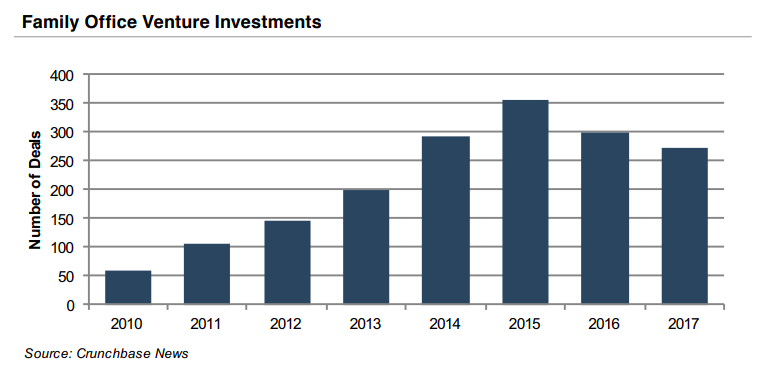
Involvement
Despite an industry focus on the new wealth being built in the technology hubs of the U.S., abundant sources of potential investment lay in family offices all over the country. Family office investors are likely to source deals through their personal networks and professional ties with local business activity. Family offices typically take an active interest in each portfolio company and, therefore, may be likely to invest their capital in local ventures in order to better stay up-to-date with company developments. In order to maintain this involvement, a board seat may also be one of the requirements when a family office joins the cap table.
Motivation
Whether they hold a share of the original family company or a subsequent business investment, family offices often have a stake in mature industry players. Because of previous work within the space or an inside vantage point from an ownership position, family offices can often lend industry insight. They may also possess a unique perspective for identifying startups that could disrupt, or partner with, the incumbents in the industry. Family office investors typically enter with strategic motivations for investing, not just the lure of large returns.
Time Horizon
The primary focus of family offices is to preserve and grow capital for multiple generations. Family offices are, therefore, usually able to adopt a very long-term view of their overall portfolio. However, it should not be mistaken that family offices are willing to have their capital tied up forever. Like any other investment firm, family offices develop objectives and exit expectations for their various investments.
As family offices join the landscape of non-traditional investors in venture capital, startups may find that they have more options when it comes to funding. We expect to continue to see an increase in the diversity of funding sources, with cap tables boasting a combination of traditional, corporate, and family investors.
Originally published in Portfolio Valuation: Private Equity & Venture Capital Marks & Trends, Third Quarter 2018.
EBITDA Single Period Income Capitalization for Business Valuation
The focus on the EBITDA of private companies is almost ubiquitous among business appraisers. This session addresses the relationship between depreciation (and amortization) and EBIT as one measure of relative capital intensity. This relationship, “the EBITDA Depreciation Factor,” is then used to convert debt-free pre-tax (i.e., EBIT) multiples into corresponding multiples of EBITDA. Mercer presents analysis that illustrates why the pervasive rules of thumb suggest that many private companies were worth 4.0x to 6.0x EBITDA, plus or minus, have had such stickiness. He will then address the likely impact of the Tax Cut and Jobs Act on private company enterprise value multiples. This session suggests a methodology based on the Adjusted Capital Asset Pricing Model, whereby business appraisers can independently develop EBITDA enterprise value multiples under the Income Approach and includes private and public company market evidence
